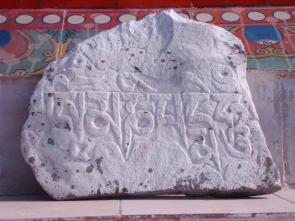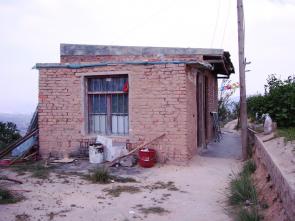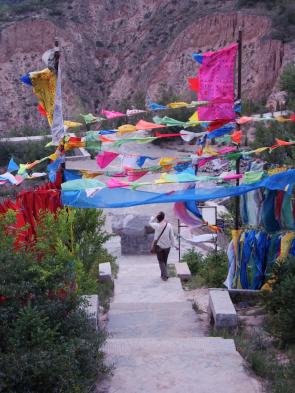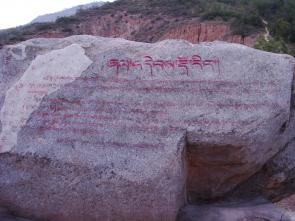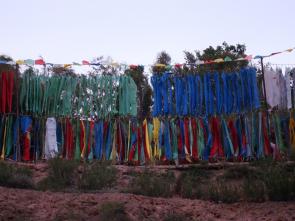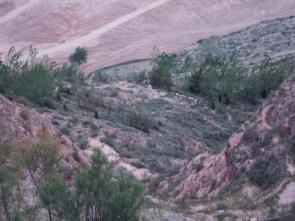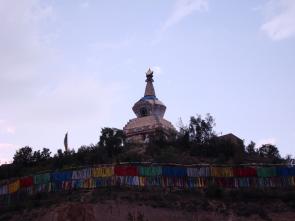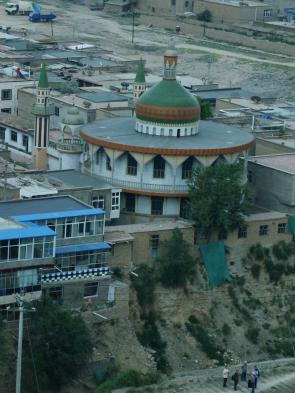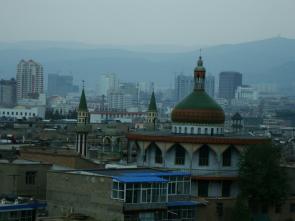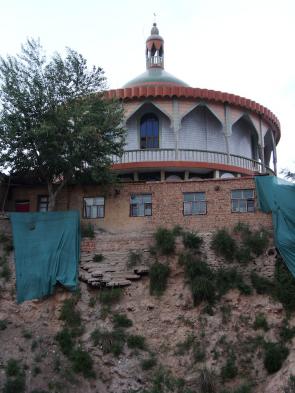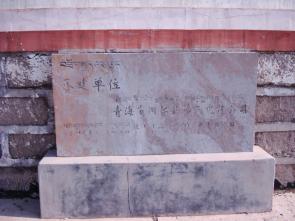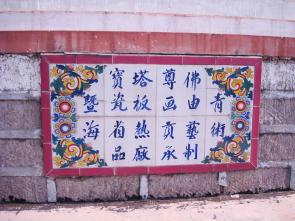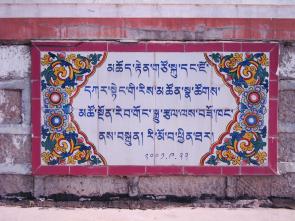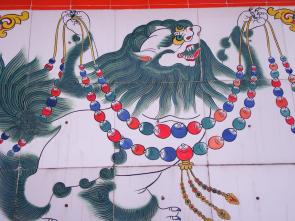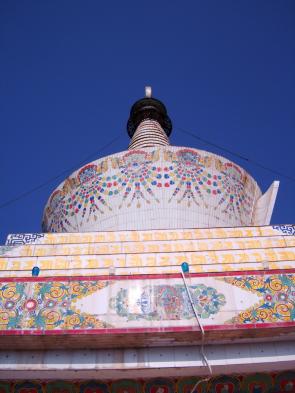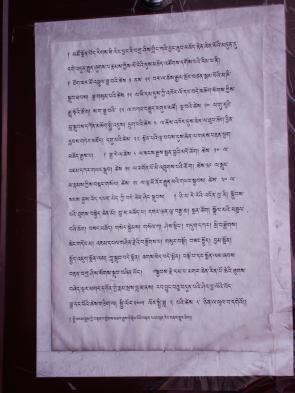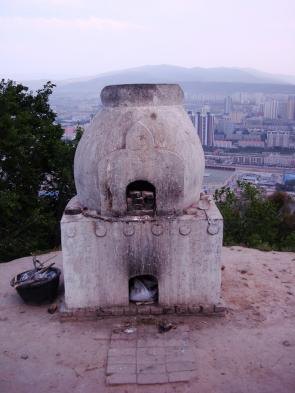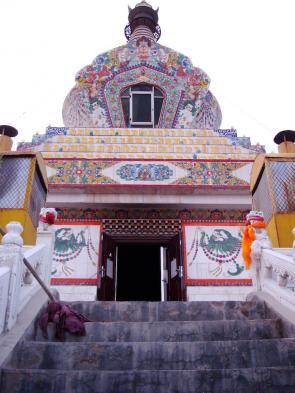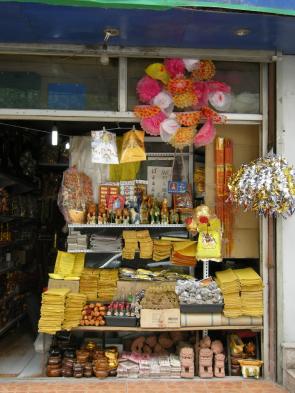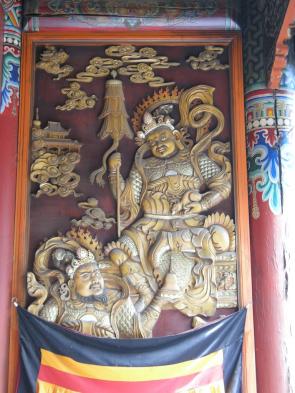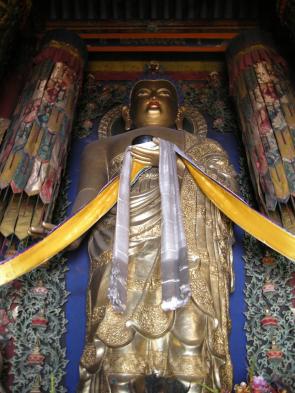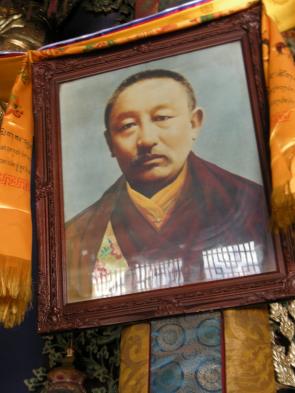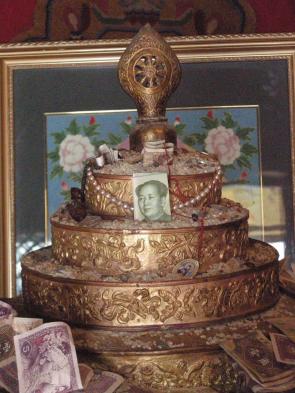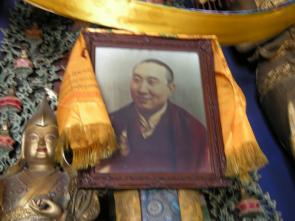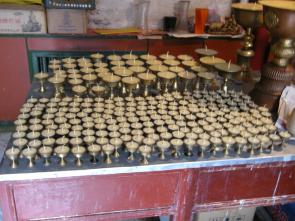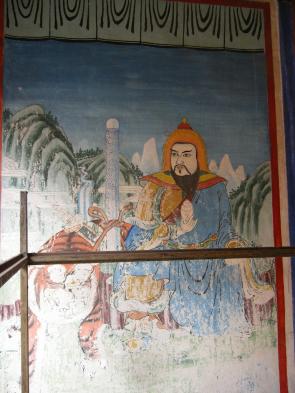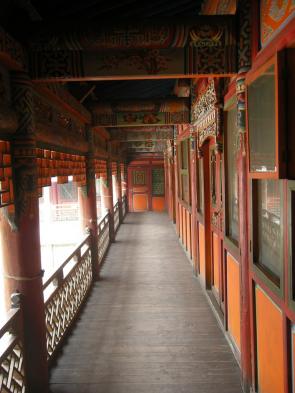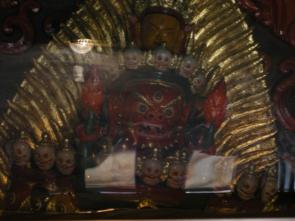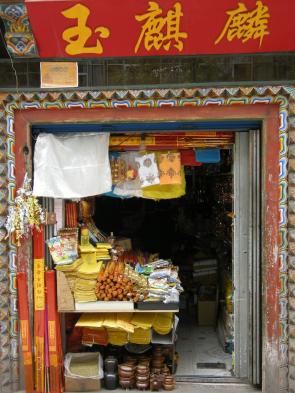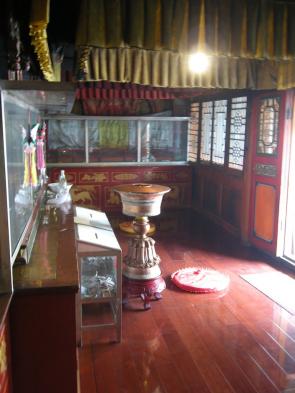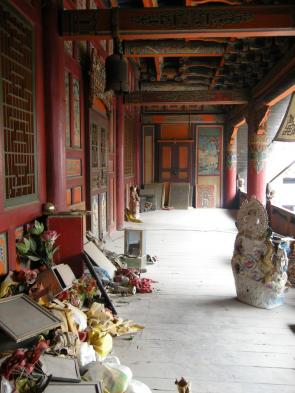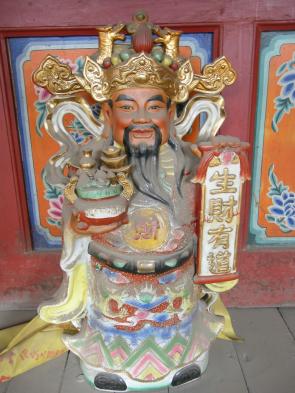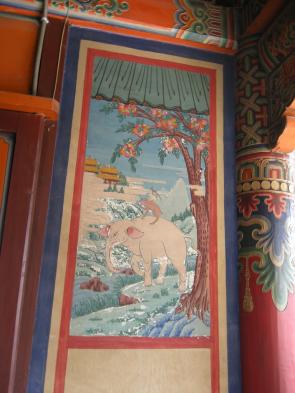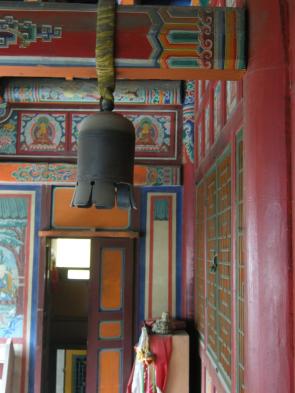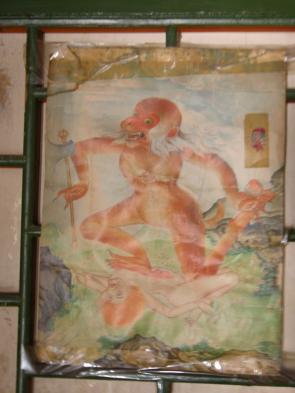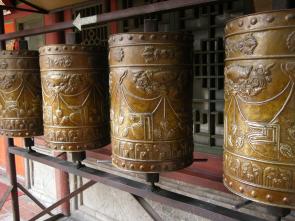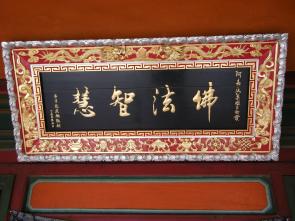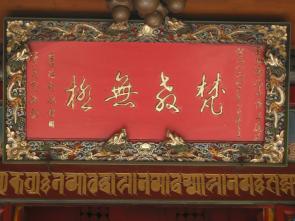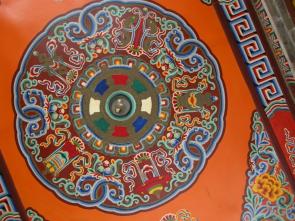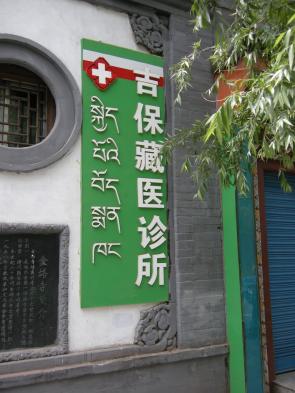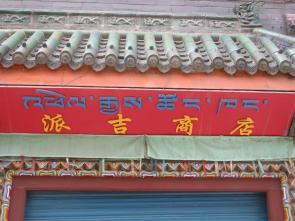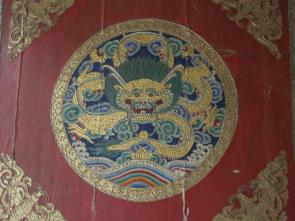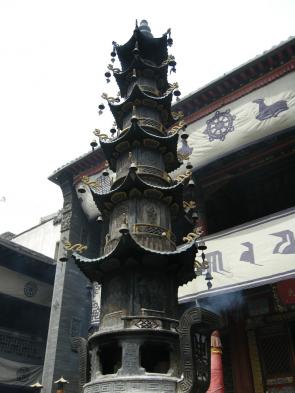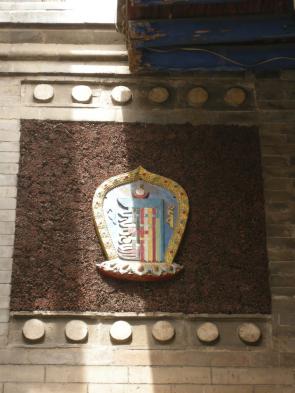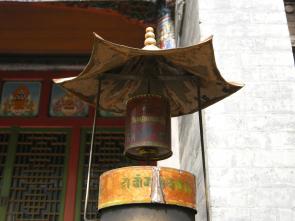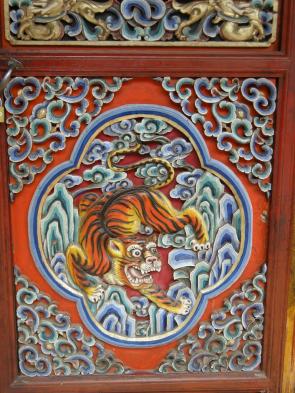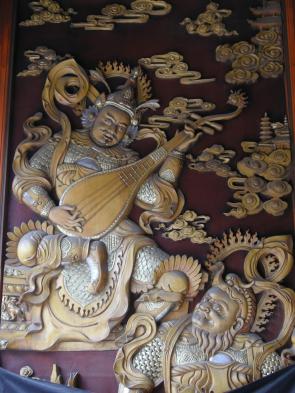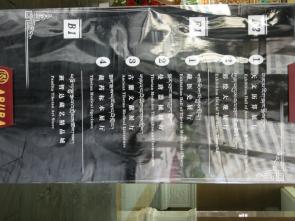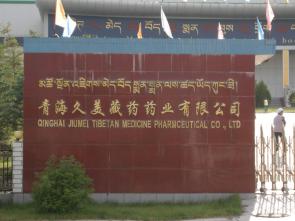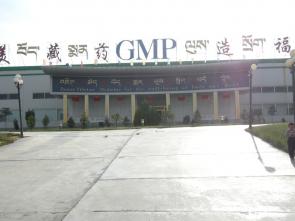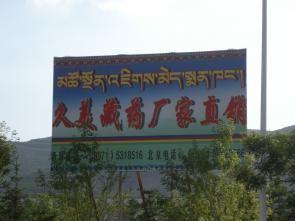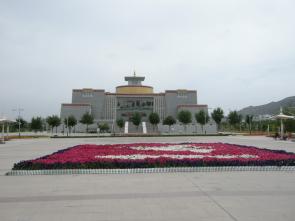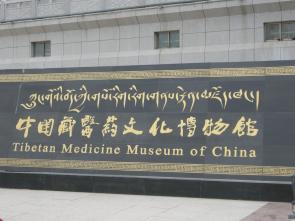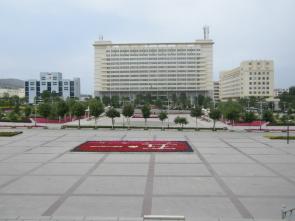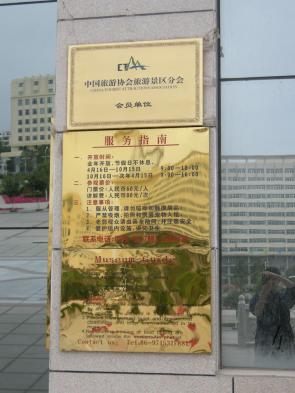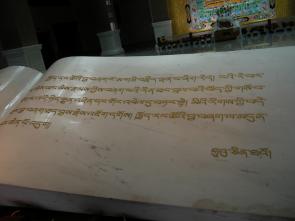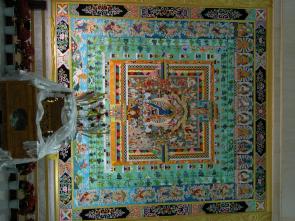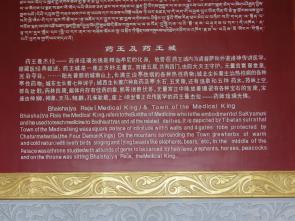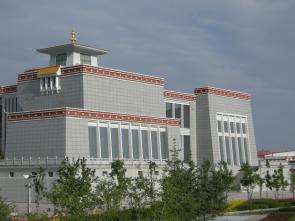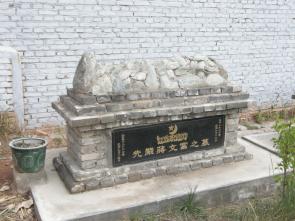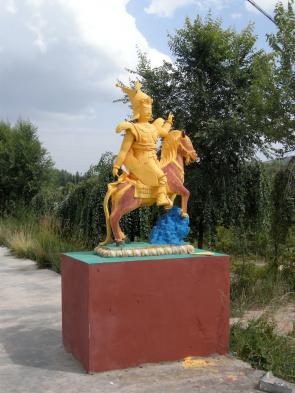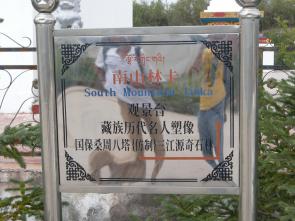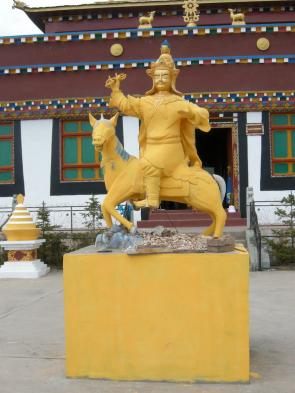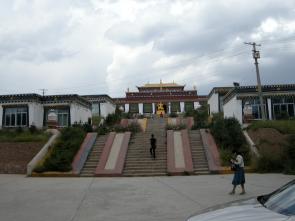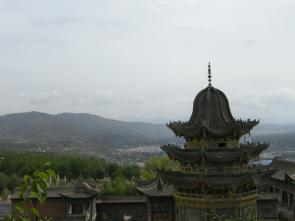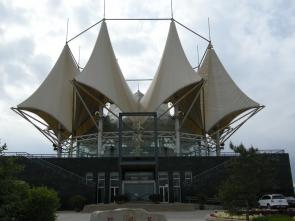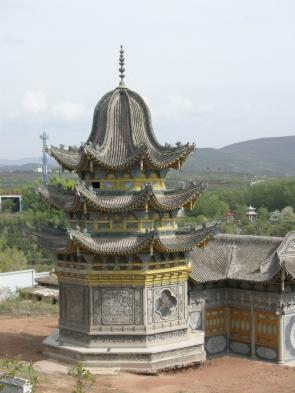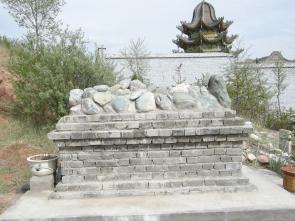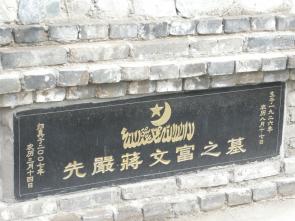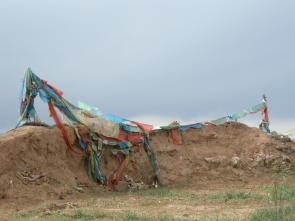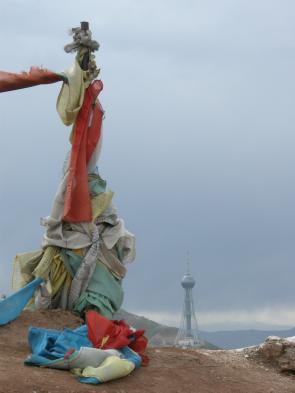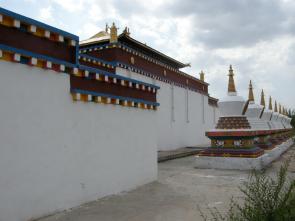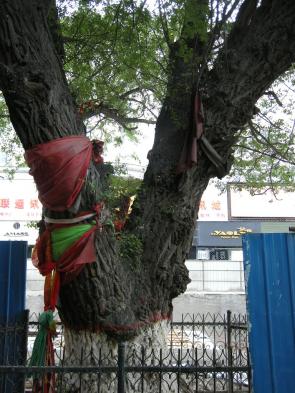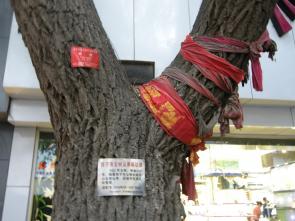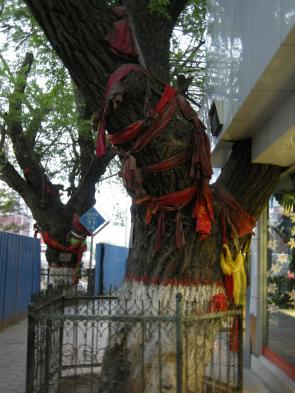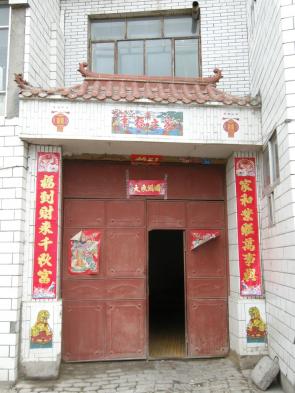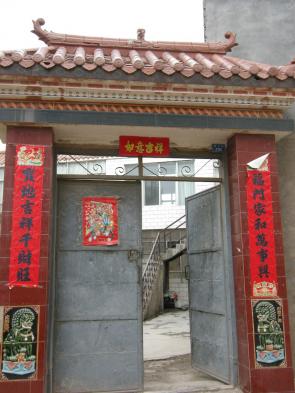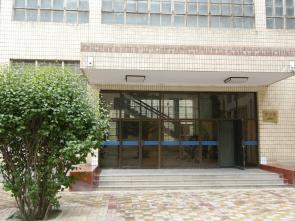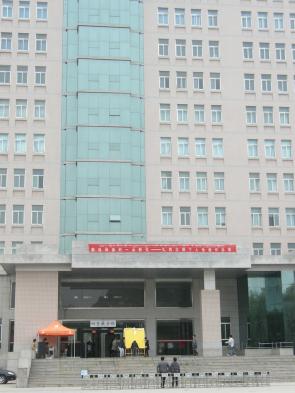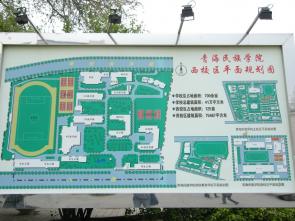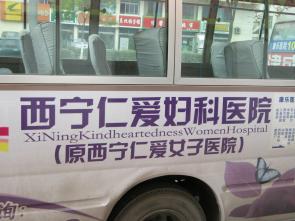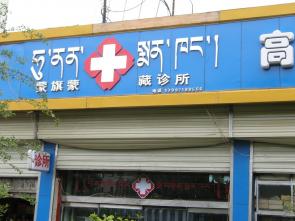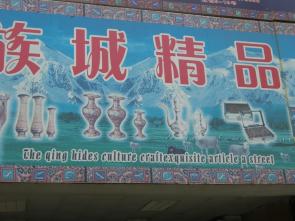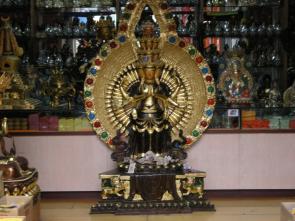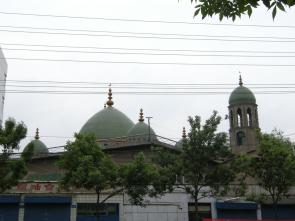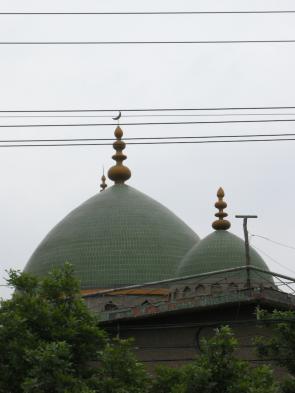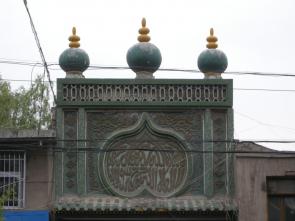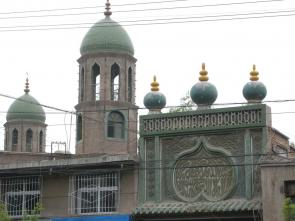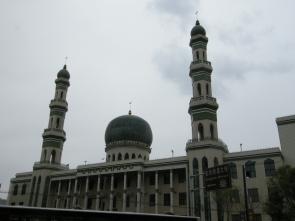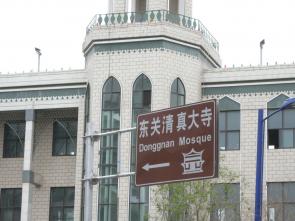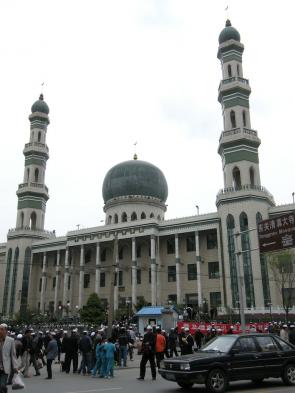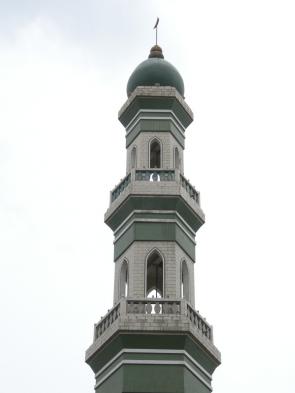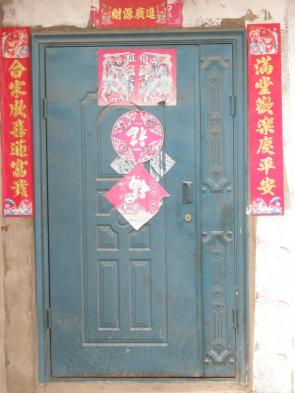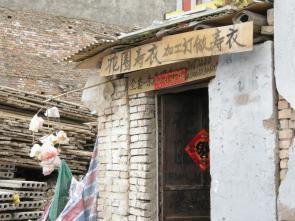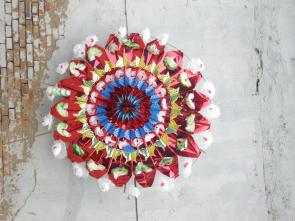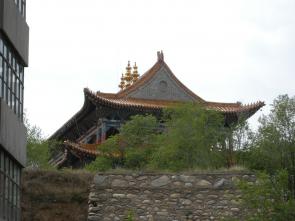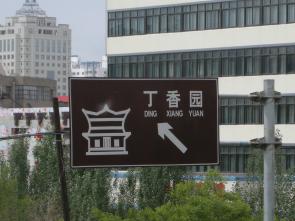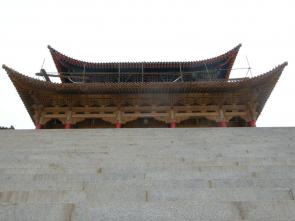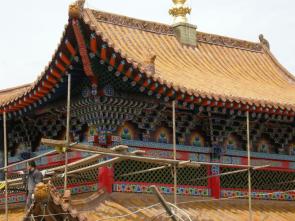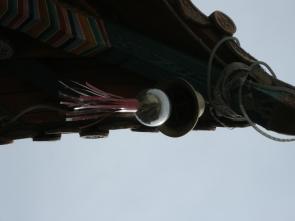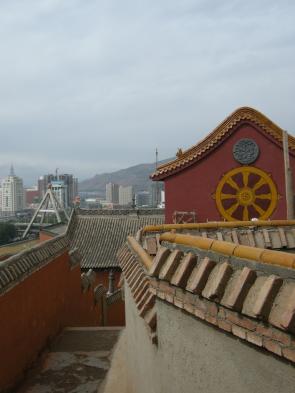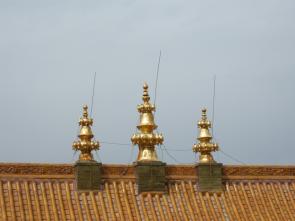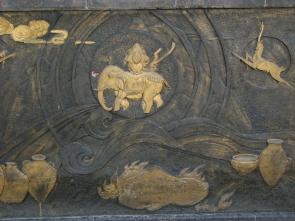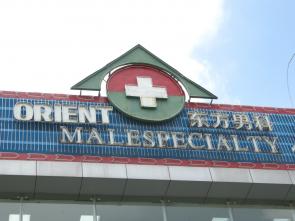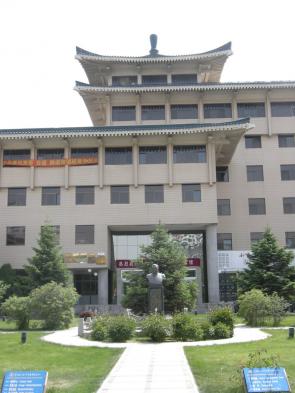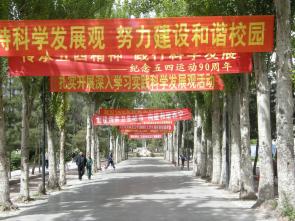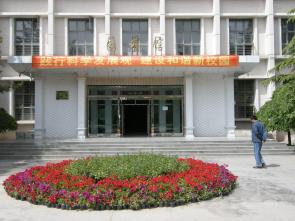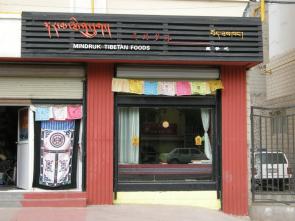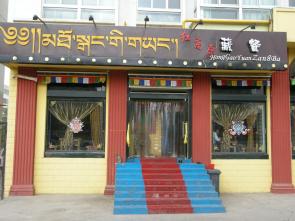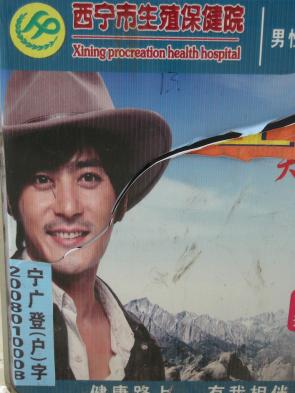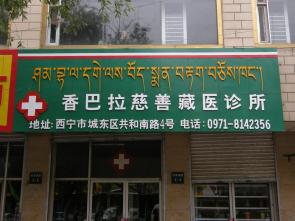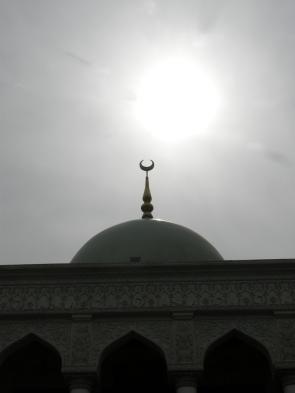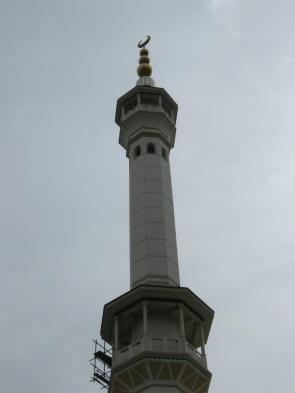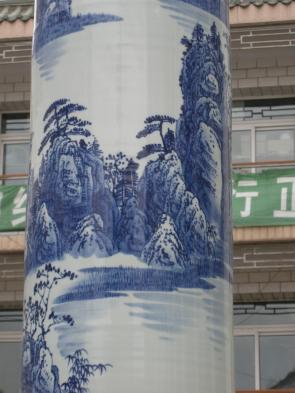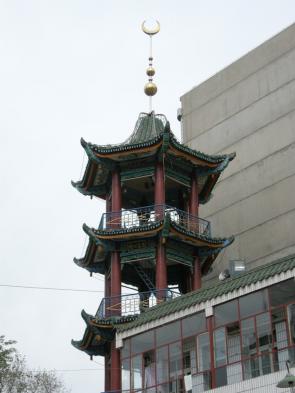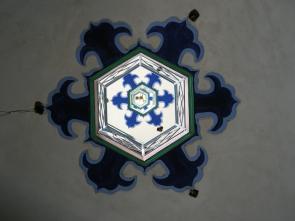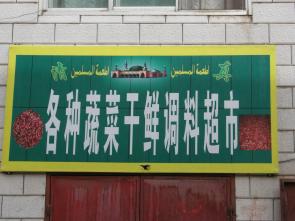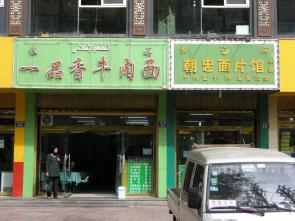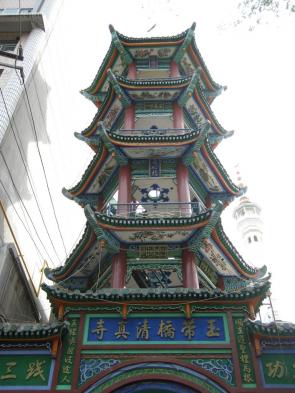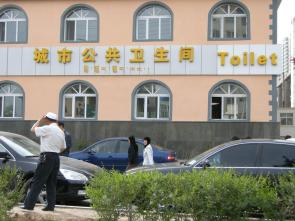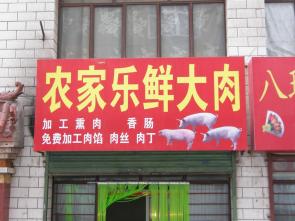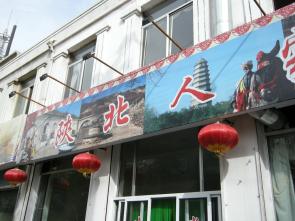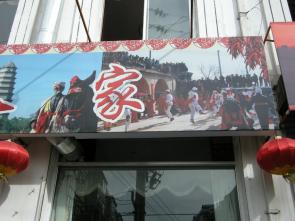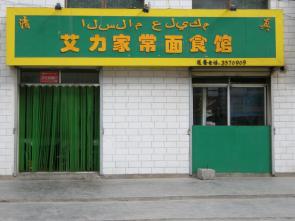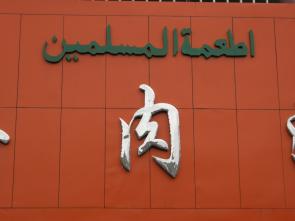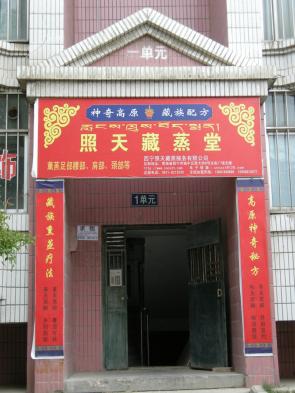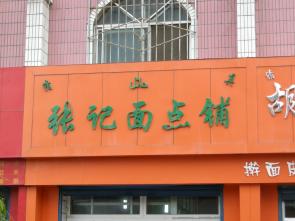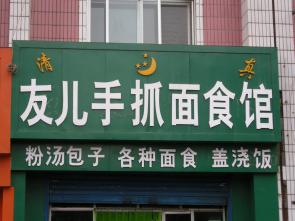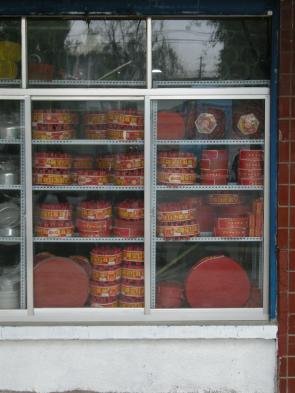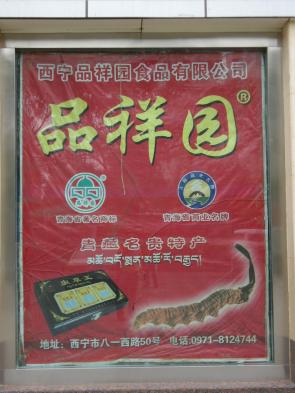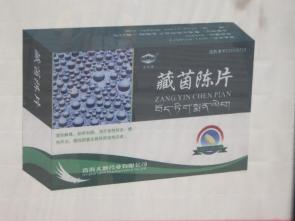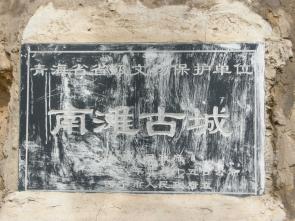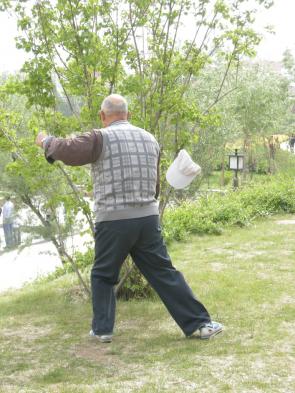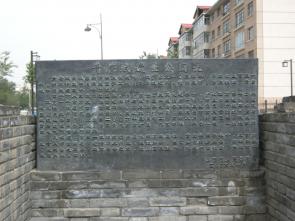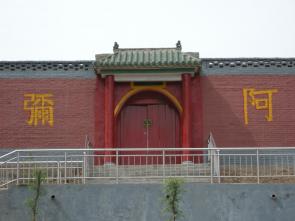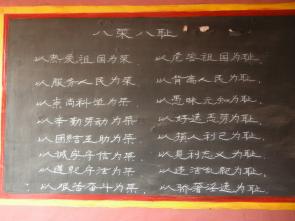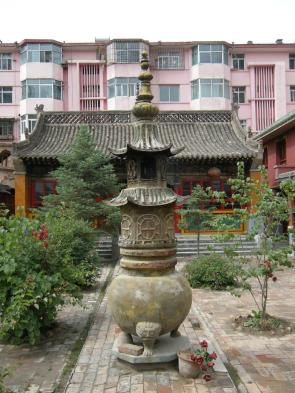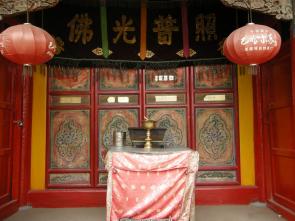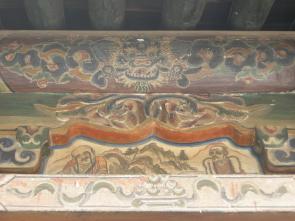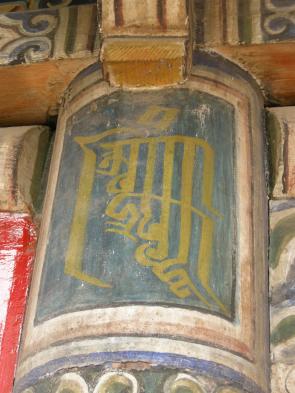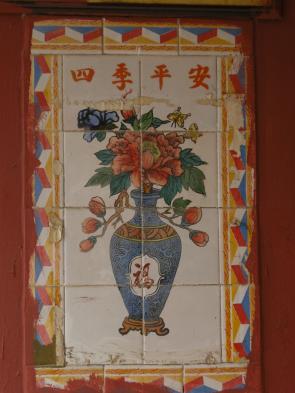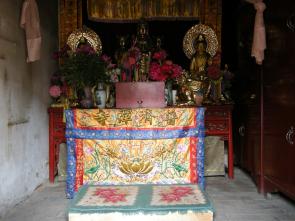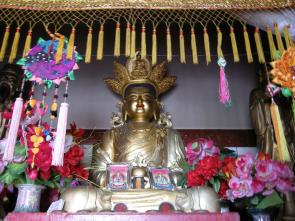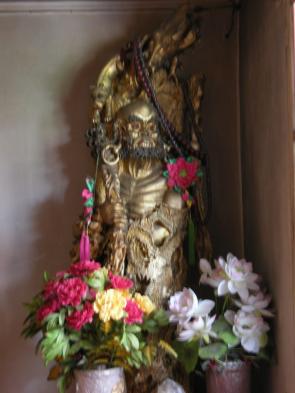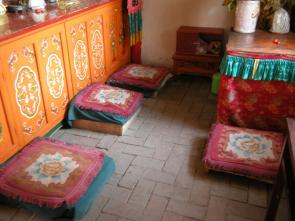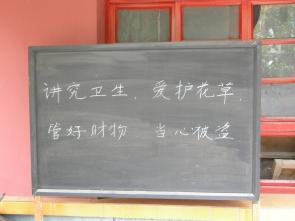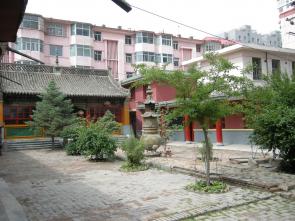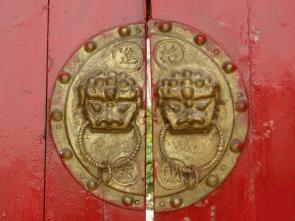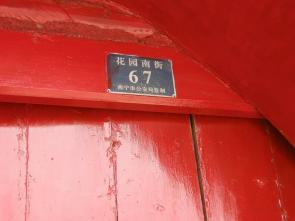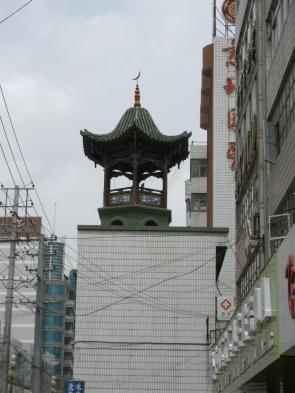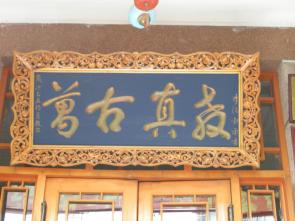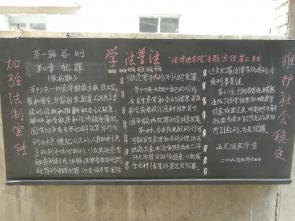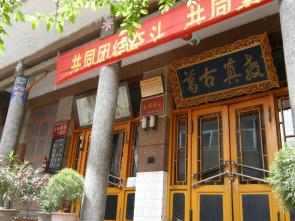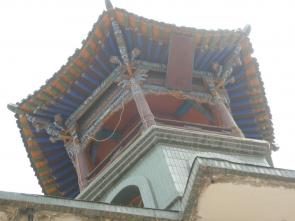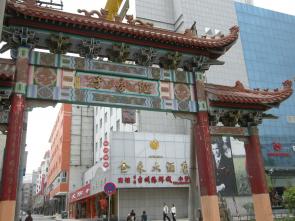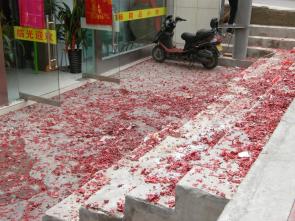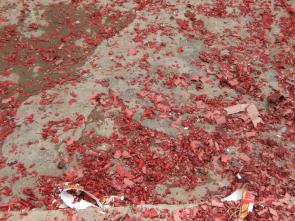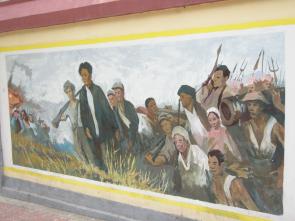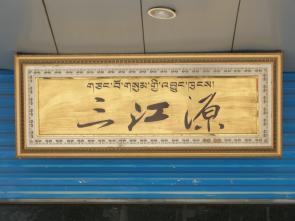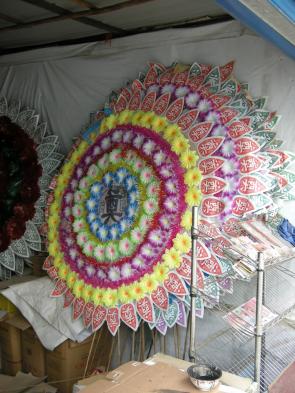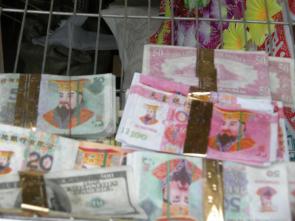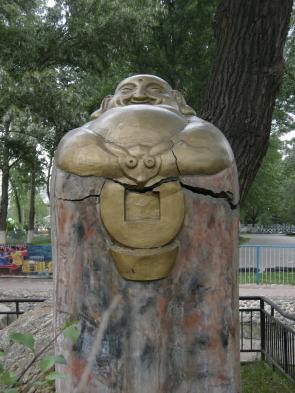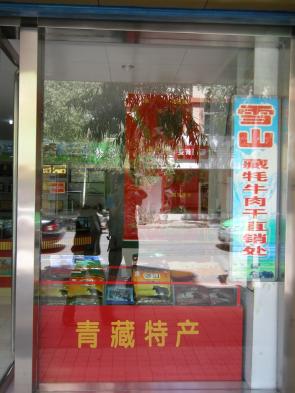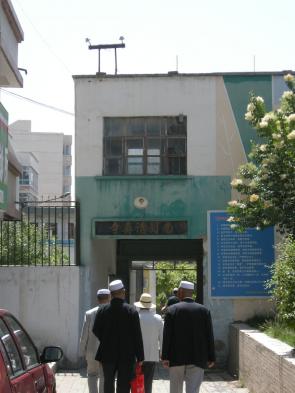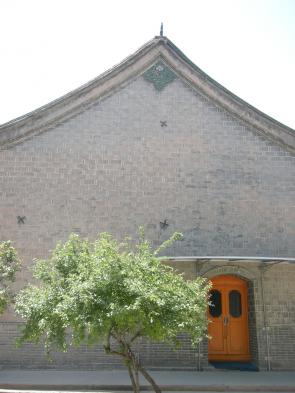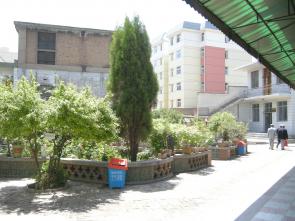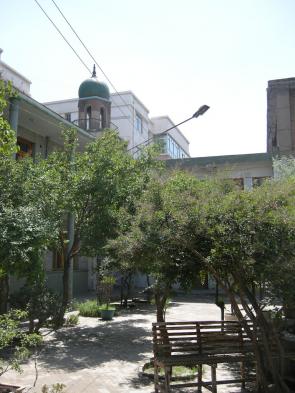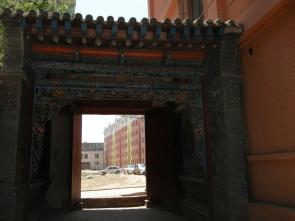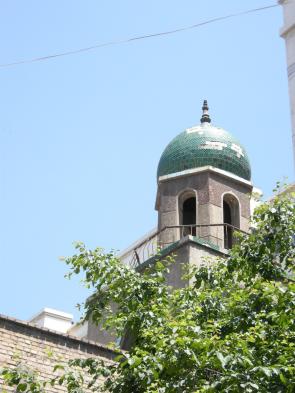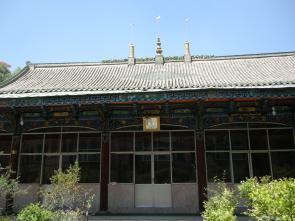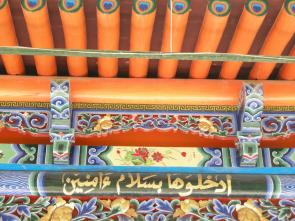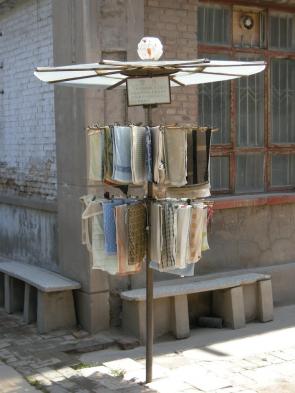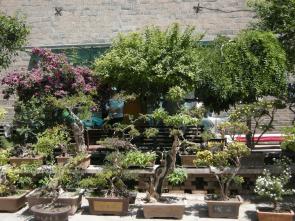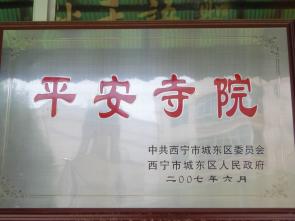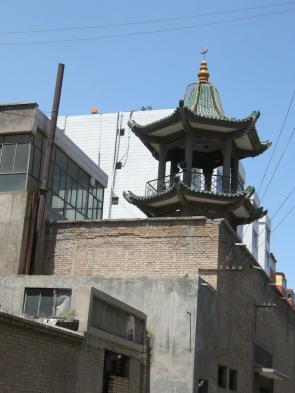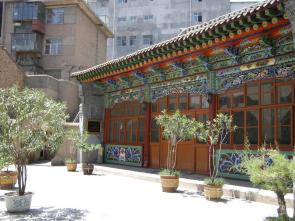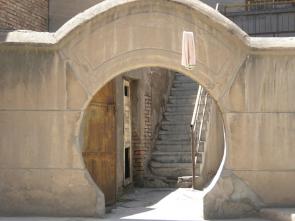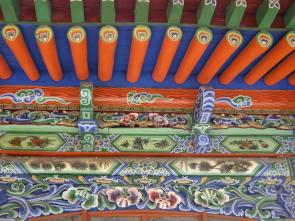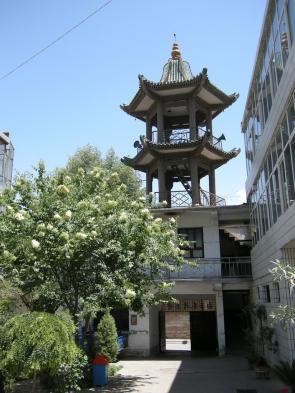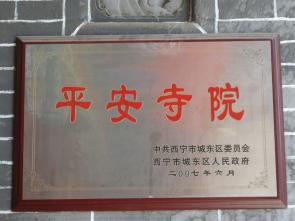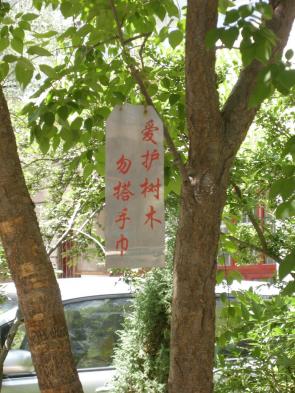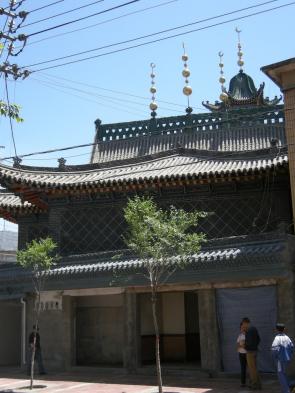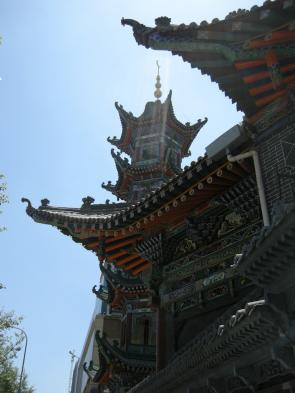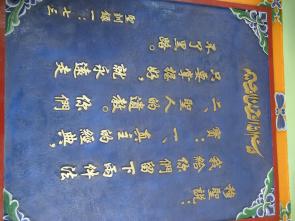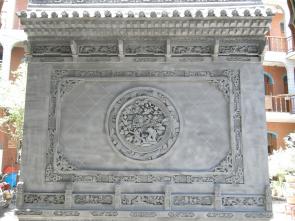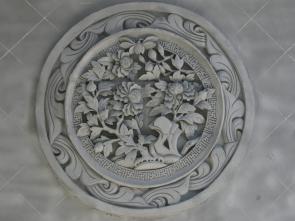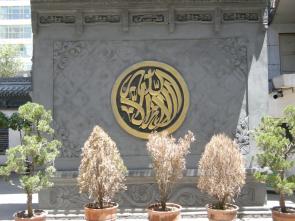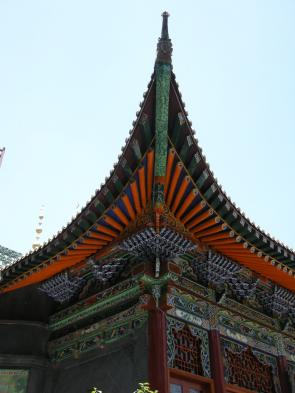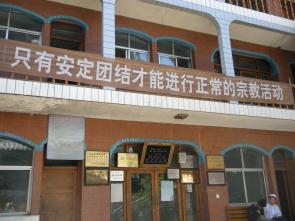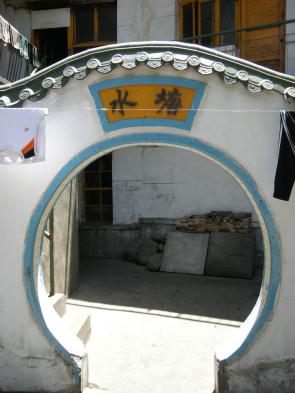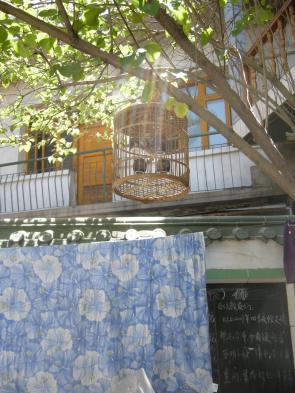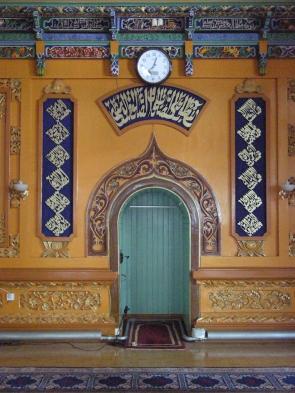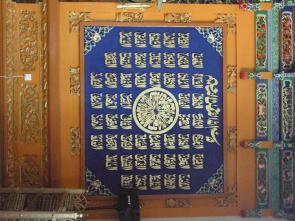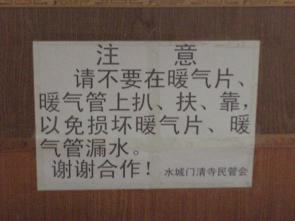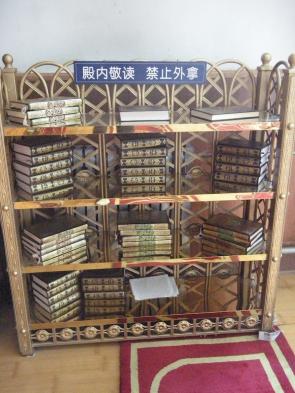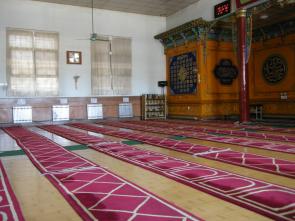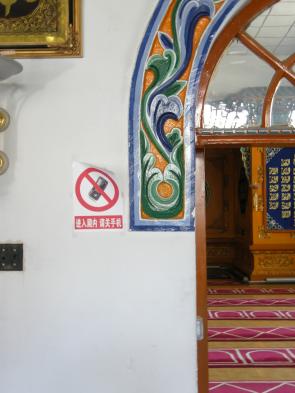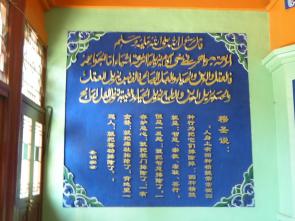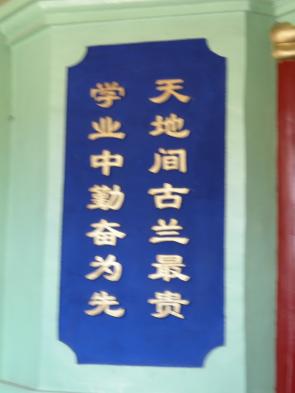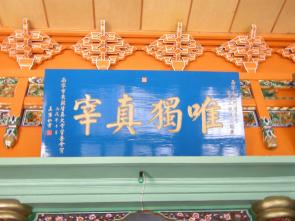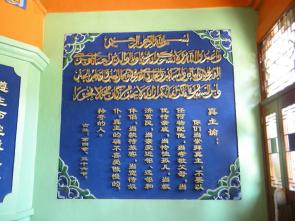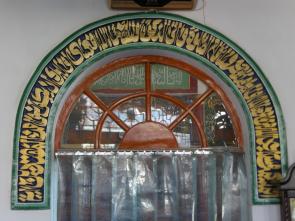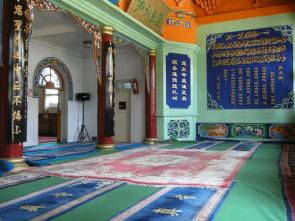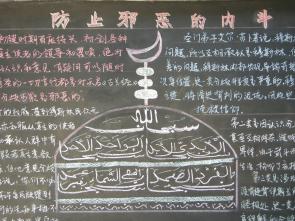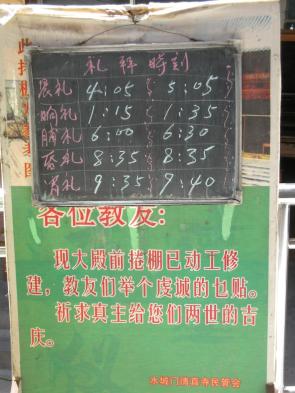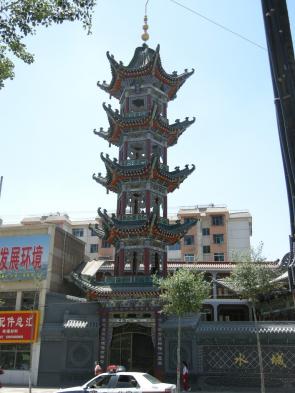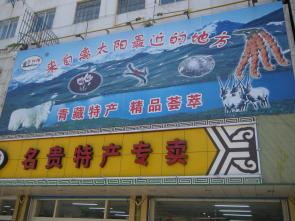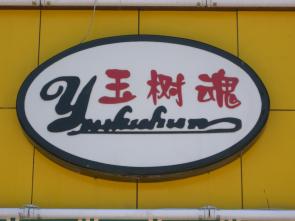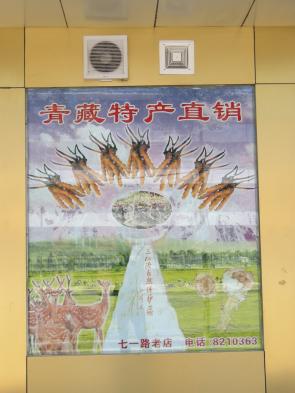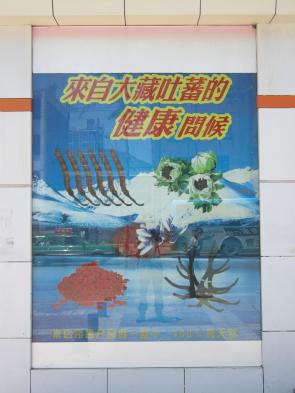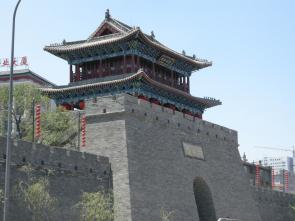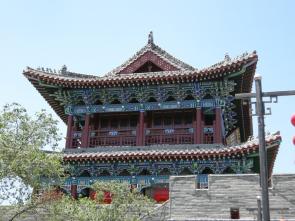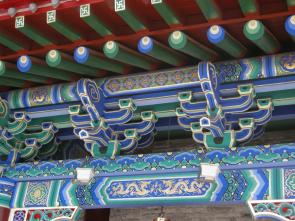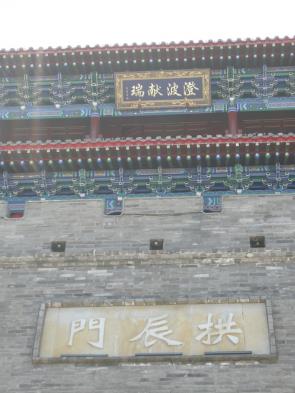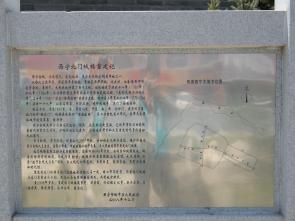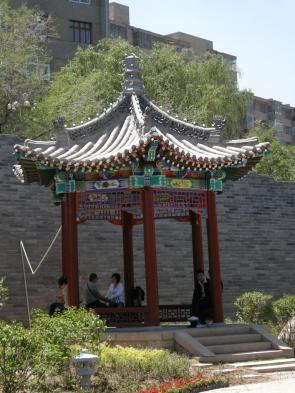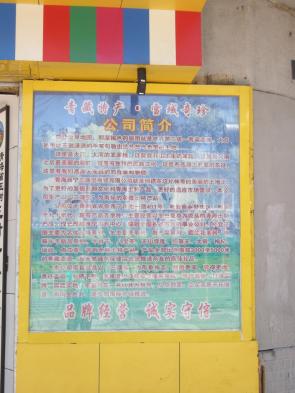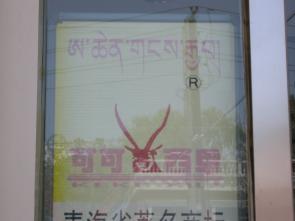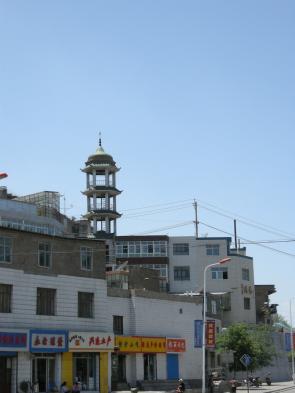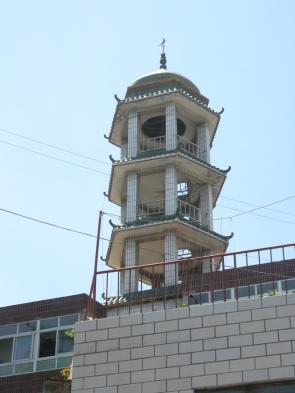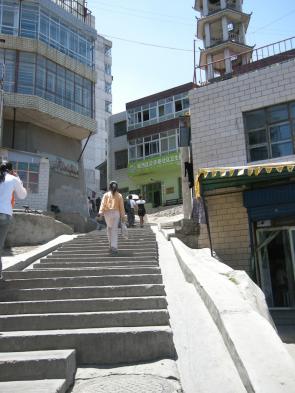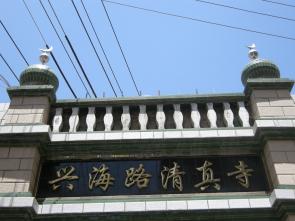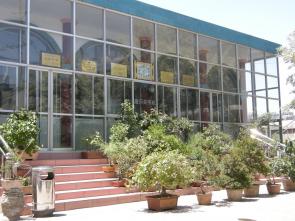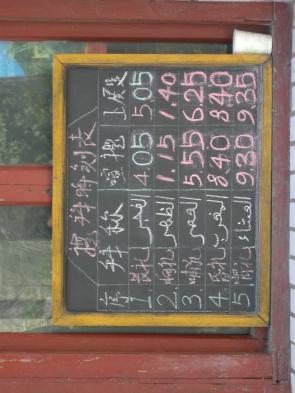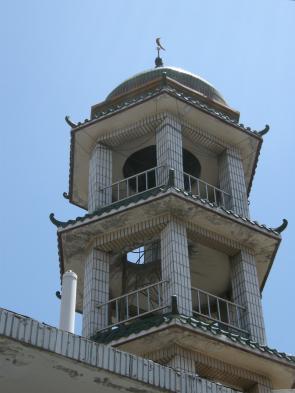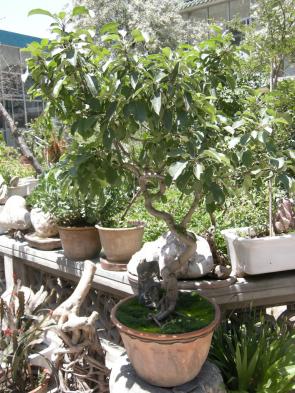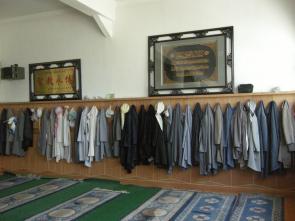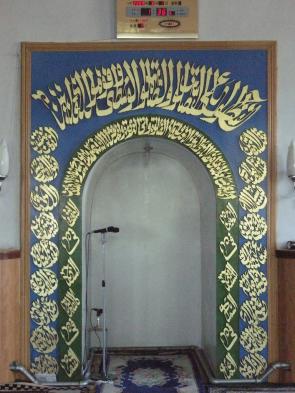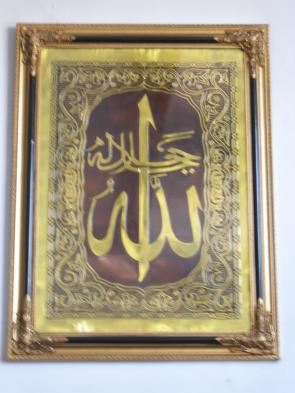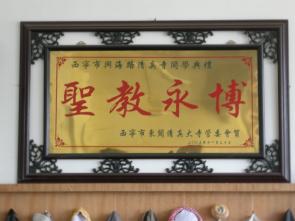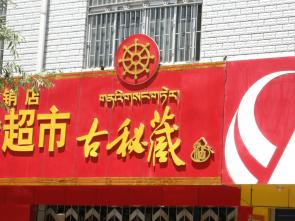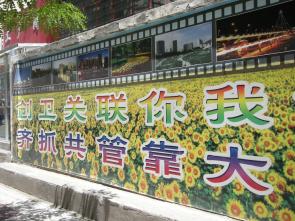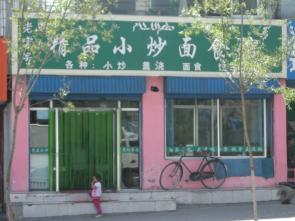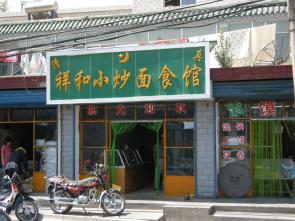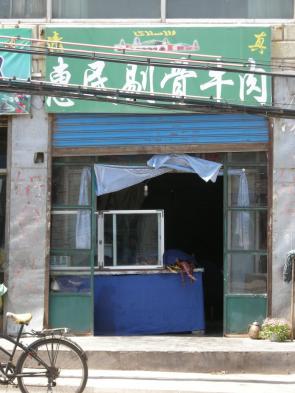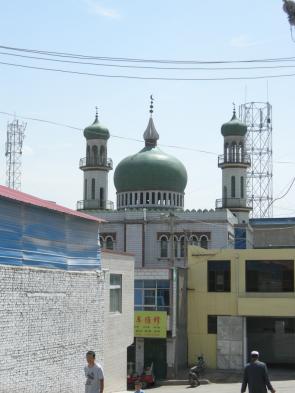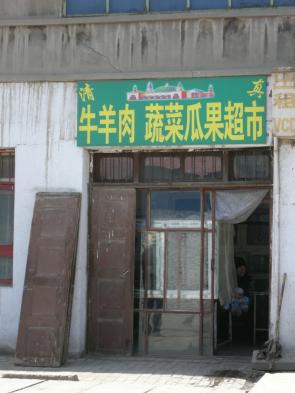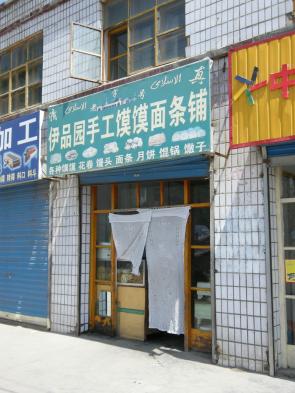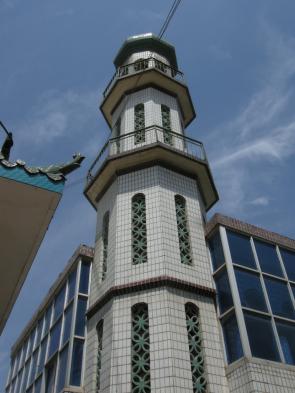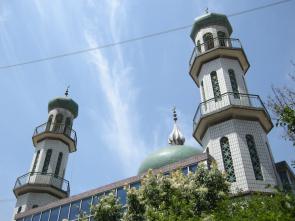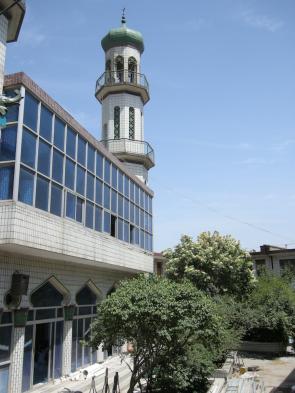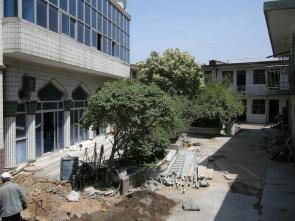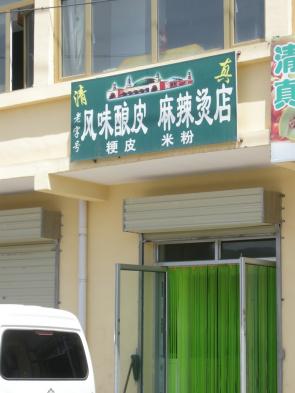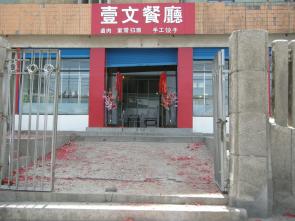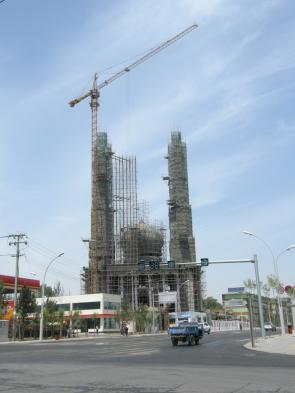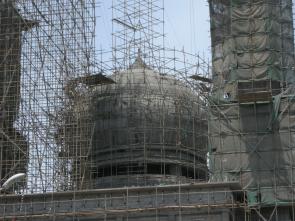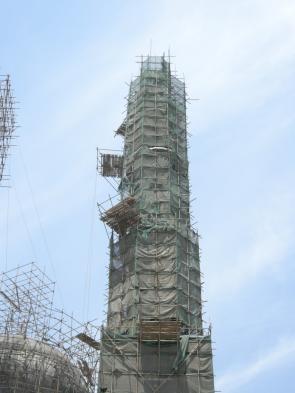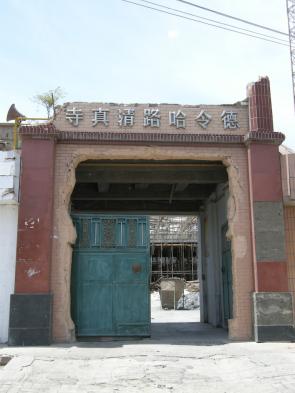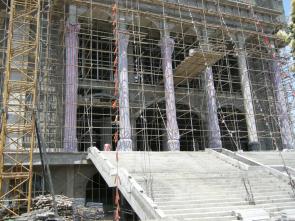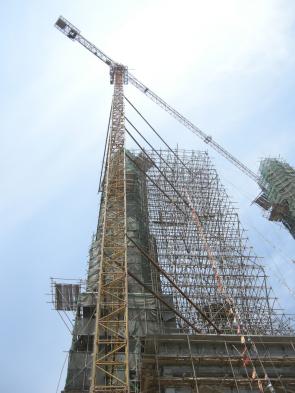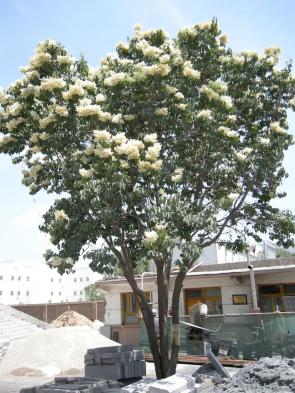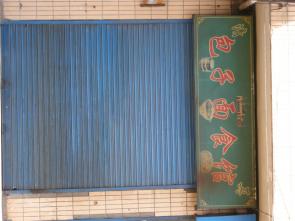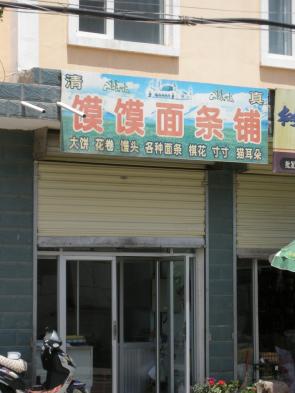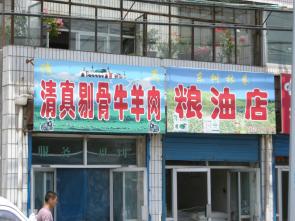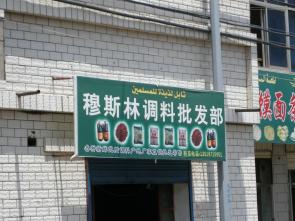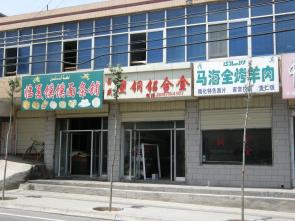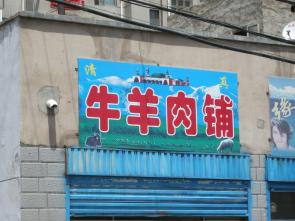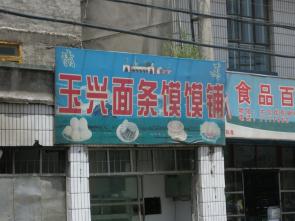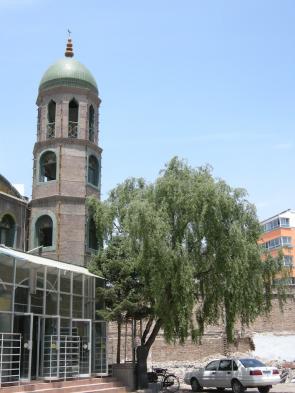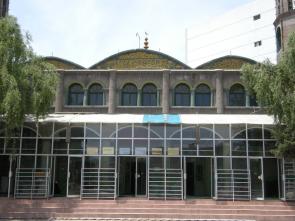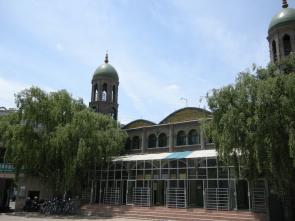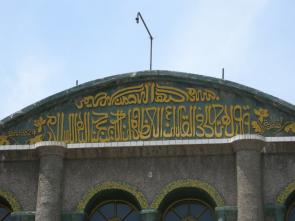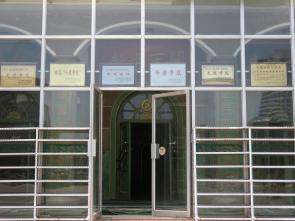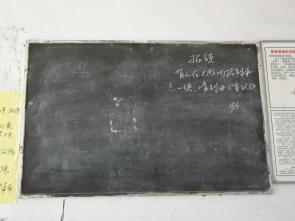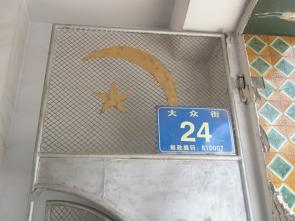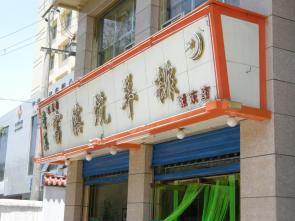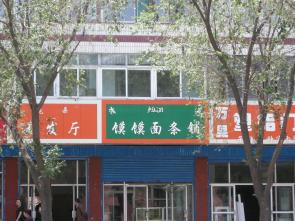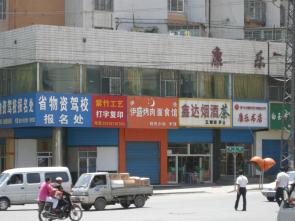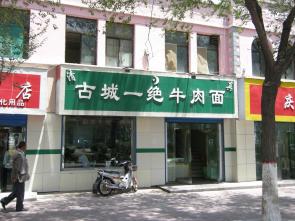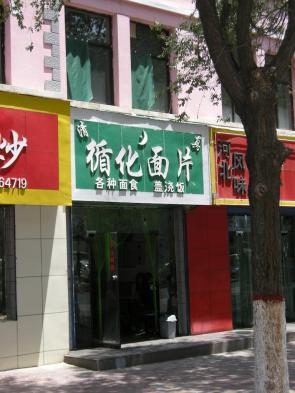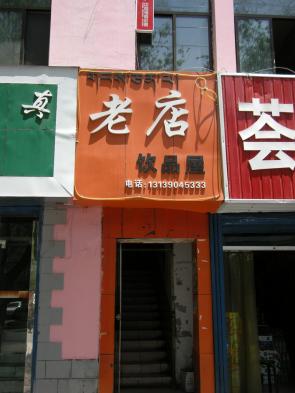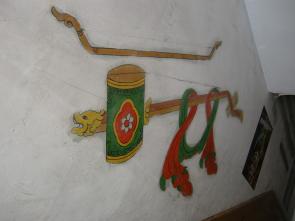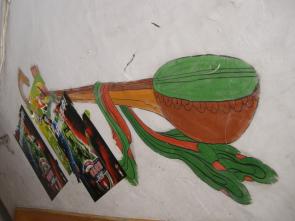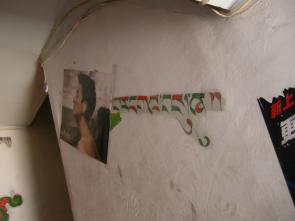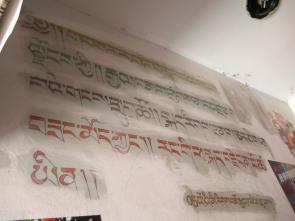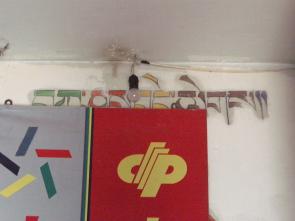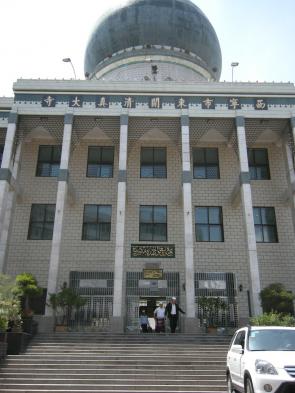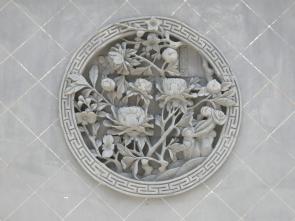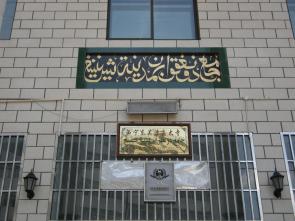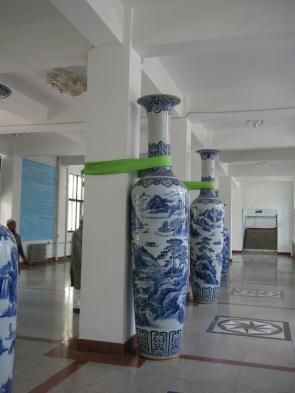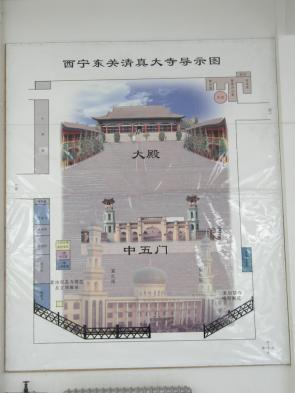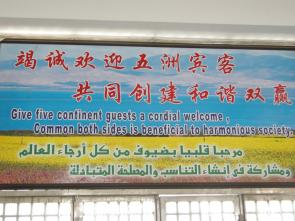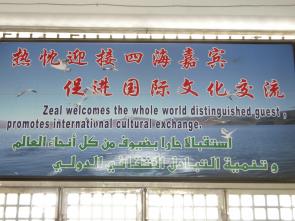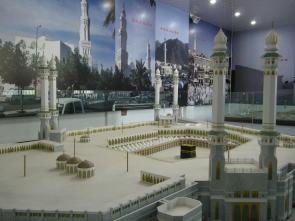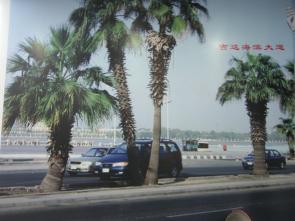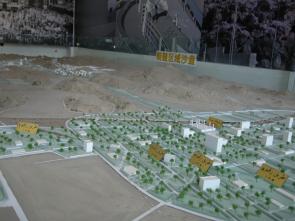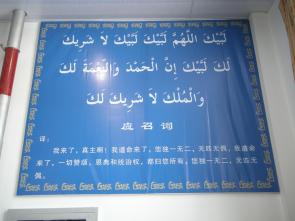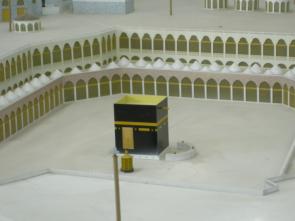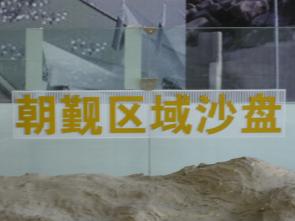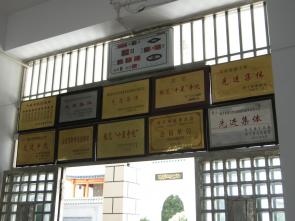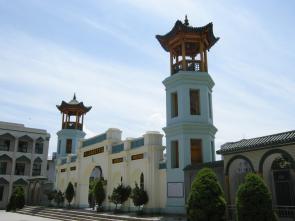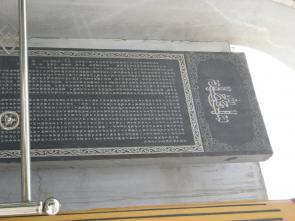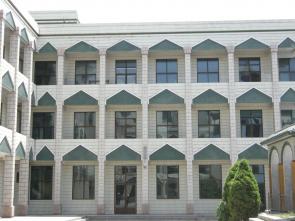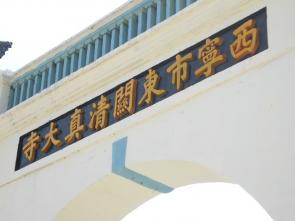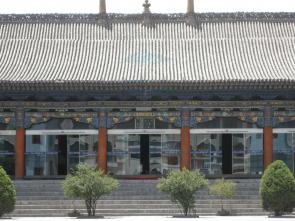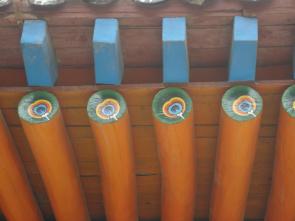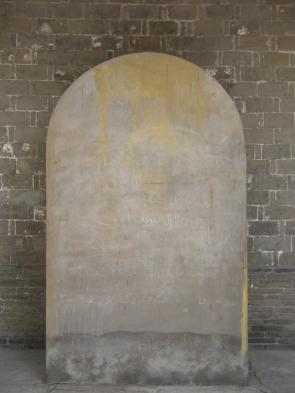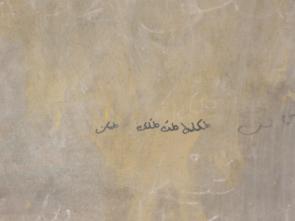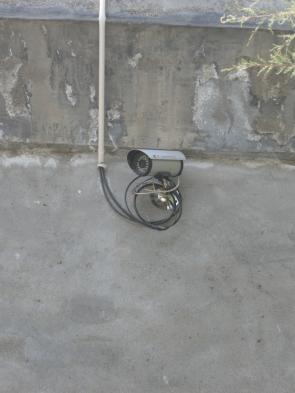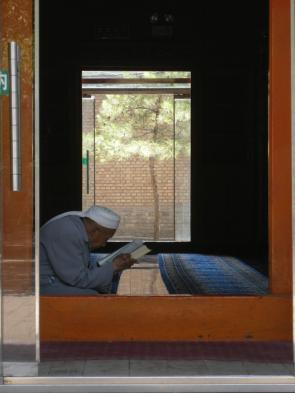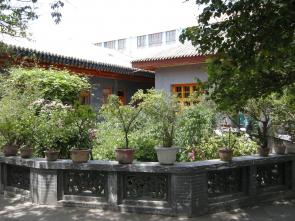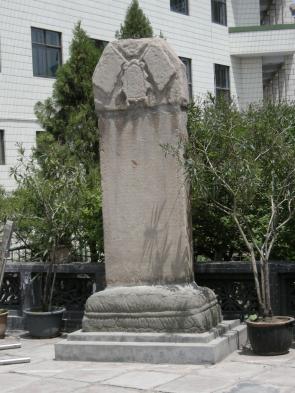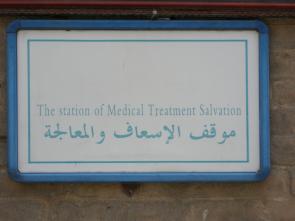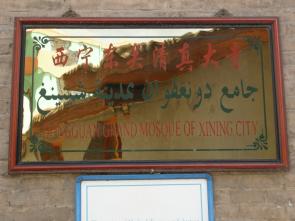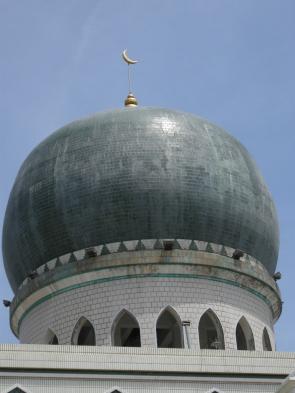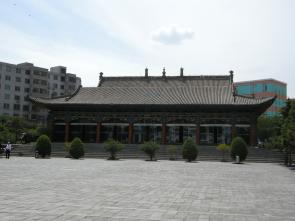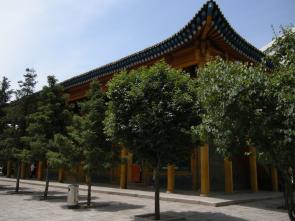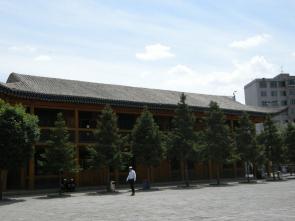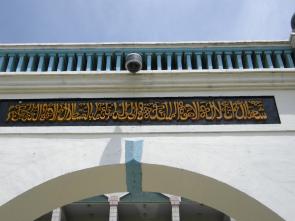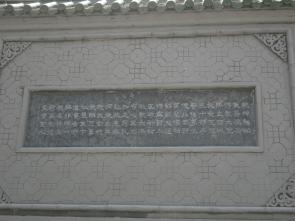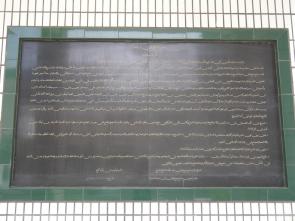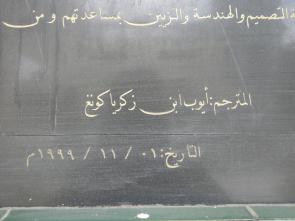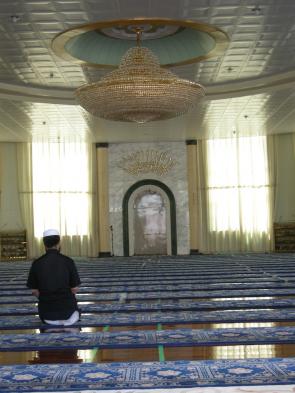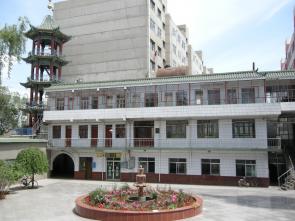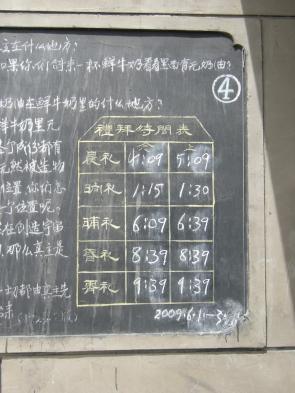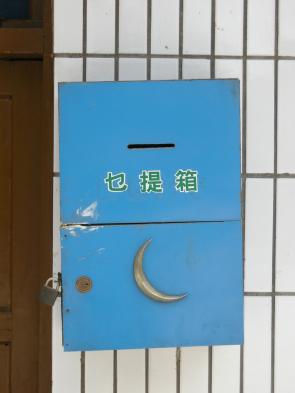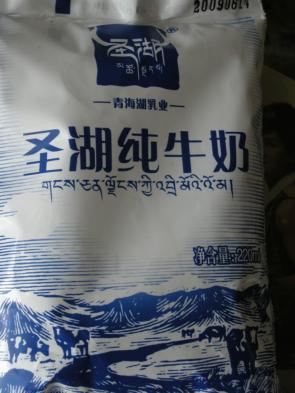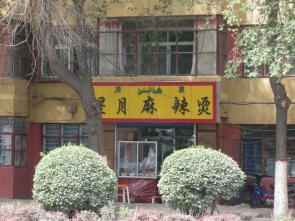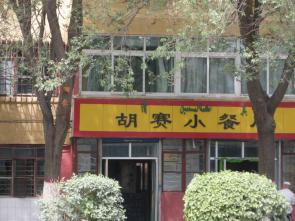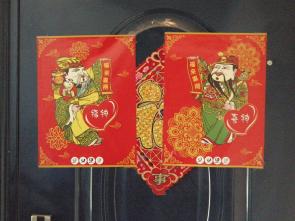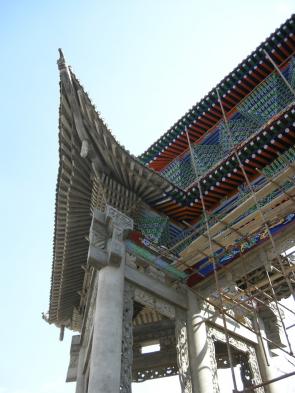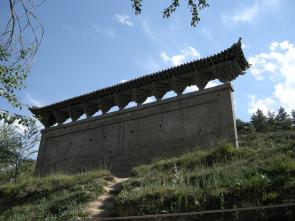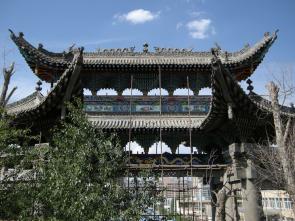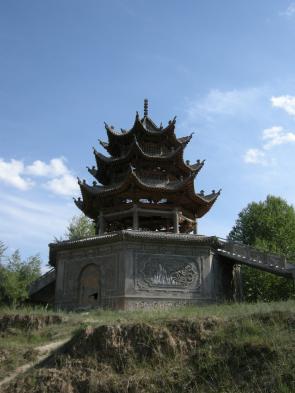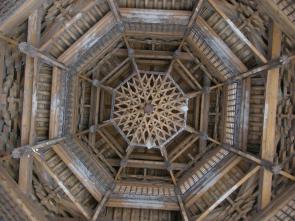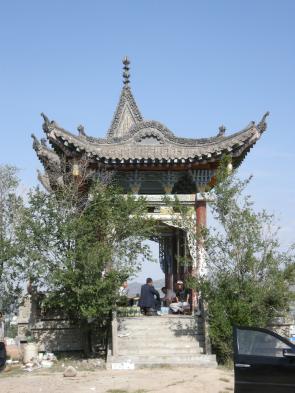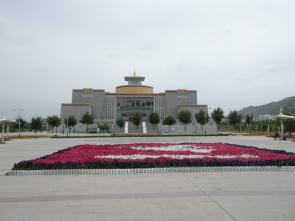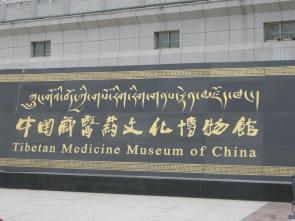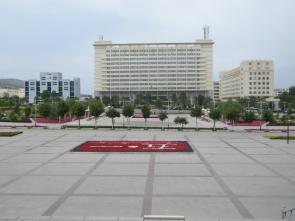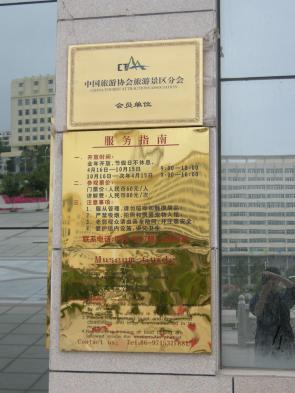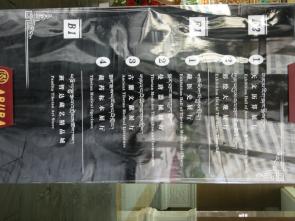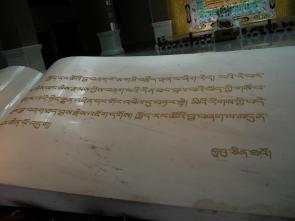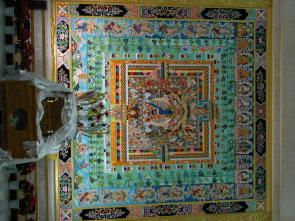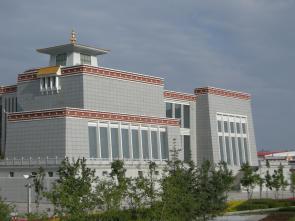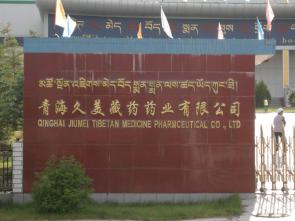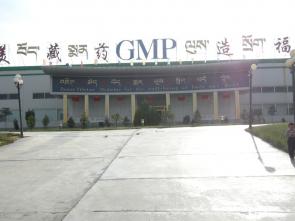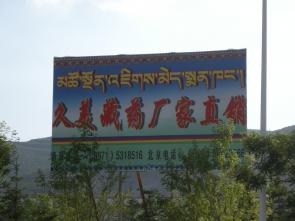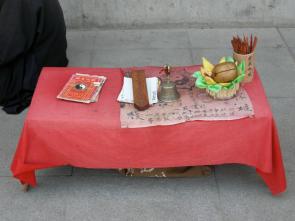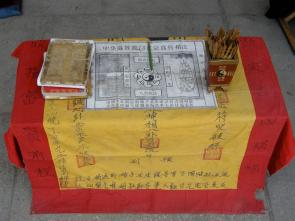Gaubatz has
an extensive entry on the history of Xining (54-62 ),
starting with the earliest archaeological records of settlements in the Xining
area to the late twentieth century. However, there is little information on
either Xining’s very early history (such as 4000 CE) and on its twentieth century
history. Overall, the entry is detailed, concise and well-sourced, relying on historical
and archaeological articles in both Chinese and English.
Gaubatz
begins the entry with a description of Xining’s geography, including elevation
and surrounding terrain. Here Gaubatz states (drawing on Chow ,
Liu & Zhao ) that members of the Yangshao
civilization were present in the Xining area as early as 4000 BCE, and to
describe the area’s early Qiang (Tibetan) and Han settlers (55 ). Following
that is a description of Xining’s history, which generally follows the
succession of dynasties in China. There is a significant emphasis on Xining’s
role as a military outpost and trading centre, and the longest part of the
entry focuses on the role of Xining in Ming era political conflicts between the
Chinese, the Mongols, Xixia (Tanguts) and Muslim groups, but little on
religious life in Xining. Gaubatz also includes frequent notes when certain
walls, buildings or important sites were constructed in Xining.
Three maps
supplement the entry, of which two are from the Qing dynasty, and one of which depicts
Xining’s walls circa. The two Qing dynasty maps are taken from the Qingahi
lishi jiyao ,
and readers are directed there for larger, more detailed versions of these
maps. While these two Qing era maps are somewhat figurative, they show the
relative positions of important sites in Xining with labels.
Place Reference:
A lone mani stone sitting on the edge of one side of the stupa. Although my party were the lone visitors to the actual stupa on that day, we did see several pilgrims on and around the mountain both head and behind us. Perhaps because of the very recent construction of the stupathere was not the build-up of religious paraphernalia (lung rta, mani stones, tsa tsa, etc.) scattered on the mountain path which are so common at other sites.
Just to the east of the stupa is this tiny building; though it appeared to be an office, it is possible the monks described in 128.jpg are living here, as there were no living quarters inside of the stupa.
A sign on the front door of the 'office' shown in 129.jpg listing the contact information of some office or individual.
Looking back down the approach to the stupa, the 'Donor's Rock' of 133.jpg is visible at the bottom of the stairs. The carving of the stairs themselves adds to the considerable expense it must have cost to build the stupa.
The stupa's 'Donor's Monument' (zhal 'debs rdo ring). Not shown is the immediately adjacent Chinese version listing the same names and information.
A sampling of the wall of prayer flags which surround the stupa. Again, these were immaculately maintained considering the winds around the stupa. This is only a taste of the ring which actually surrounds the stupa, fluttering with a great clatter during my visit.
On the side of Bei Shan mountain several graveyards can be found, though the ethnicity of their denizens could not be ascertained. In my travels outside of Xining I have seen similar circumstances in which graveyards are located nearby to stupas. Due to the very recent construction of the stupa, and the tendency against burying one's dead for Tibetans, I would posit these graves are more likely to be associated with the nearby Daoist monastery.
The stupa as seen from a distance. In fact it is visible from many points within Xining city proper. Whether this extreme visibility has political ramifications/undertones is at this time unknown. More research into the building of this monument is certainly warranted.
A uniquely designed and coloured mosque visible when one descends from the Bei Shan stupa via an eastern running path. Shown in increasing proximity. N.B. the extremely pointed minarets, a unique style for this somewhat remote mosque.
A uniquely designed and coloured mosque visible when one descends from the Bei Shan stupa via an eastern running path. Shown in increasing proximity. N.B. the extremely pointed minarets, a unique style for this somewhat remote mosque.
A uniquely designed and coloured mosque visible when one descends from the Bei Shan stupa via an eastern running path. Shown in increasing proximity. N.B. the extremely pointed minarets, a unique style for this somewhat remote mosque.
Plaques in Chinese and Tibetan adorning the front of the large stupa poised on Xining's North Mountain (Bei Shan) and adjacent to the Daoist monastery - with the stupa being to the east. The title of this plaque reads, 'Manufacturing Office' with the next line containing the word "thun rin rdzong" which I take to be a transliteration for the Chinese 'Tongren' county. This is especially strange considering Tongren has a well-established Tibetan name, Rebkong. This refers to the origin of the artisans who crafted the stupa.
Plaques in Chinese and Tibetan adorning the front of the large stupa poised on Xining's North Mountain (Bei Shan) and adjacent to the Daoist monastery - with the stupa being to the east.
Plaques in Chinese and Tibetan adorning the front of the large stupa poised on Xining's North Mountain (Bei Shan) and adjacent to the Daoist monastery - with the stupa being to the east.
Vividly painted on tiles applied to the side of the stupa, shown here is a snow lion holding two garlands of wish-fulfilling jewels (nor bu). N.B. this is only one of many such figures painted on the stupa.
Looking up just beneath the stupa's south-side entrance. This displays one of the freshest looking paint jobs I have seen during my time in Amdo, despite the fierce winds which daiily batter the summit.
A worship schedule on the inner door of the stupa, which according to a preliminary translation reads: "As for the necessary meeting of fixed ceremonies of the stream-enterers - the sangha - in front of the great stupa bKra shis gling ka of the north mountain of Tibetan Xining, Qinghai which is a clear realization: At the beginning of the miracle month, the first to the fifteenth, is the tantric liturgy for the profound "Chos rgyal srung btsan".
A well-used offering burner just outside the stupa; it faces northeast and is pointed directly at the door of the stupa.
Showing this stupa's unusual inclusion of an entrance. On the day of my visit there were three monks inside performing a ritual of some sort including chanting and musical performance. Other than the monks and my party there was no one else present.
Side-by-side religious paraphernalia shops located just next to the entrance of 'Temple (Central Xining)'. Their presence, the lack of any monks inside the temple, and the multiple SUV's which I found inside the temple's considerably small courtyard seem to all incidate the use of this temple primarily as a tourist site. I have listed them as 'Chinese Busineses' in light of the absence of Tibetan writing on their outside signs.
Some paintings and sculptures displayed on the courtyard walls. Two kings [?] on opposite walls before the entrane to the temple's main Buddha-hall. The clouds in the background are in line with those described in Robert Beer's 'The Encyclopedia of Tibetan Symbols and Motifs'.
The temple's central [Shakyamuni?] Buddha-statue, roughly one story tall.
Two photos of the temple's [former?] lamas inside of the Buddha-hall. By their robes and surrounding decorations they appear to be Geluk-pa.
Directly beneath the temple's main Buddha sits this mandala display with a 1 RMB bill conspicuously folded to prominently display the face of Mao Zedong. A follow-up visit could determine whether this is a permanent fixture of the temple. Although many Buddhist sites I have been to around Xining will feature a portrait of Mao to display their political allegiance, this is the most explicit symbol of the appropriation of religious authority I have witnessed.
Two photos of the temple's [former?] lamas inside of the Buddha-hall. By their robes and surrounding decorations they appear to be Geluk-pa.
Inside one of the smaller rooms on the first floor of the temple sat three women making these butter lamps, which evidently were also for sale. The women were dressed in plain working clothes and did not give me the impression of being nuns. Besides them, the only persons at the temple were some Tibetan visitors who briefly prostrated to the central Buddha and left.
An indoor mural along the catwalks of the second floor, subject unknown. It looks as though the tiger has been lashed to the pole in the background, while the man holds up a single wish-fulfilling jewel.
Looking down a balcony of the second floor. Many of the doors coming off this hallway were locked and large sections of the second floor were in a state of disrepair.
Taken from a corner of the temple's second-floor balcony, this picture gives some sense of the temple's layout. The first-floor entrance in the background accesses the shrine shown in DSCN0619-0626. The housing division in the far background betrays this temple's urban surroundings.
Inside one of the side-rooms of the second floor. Poor lighting conditions required I shoot at an elevated ISO. Here shows a close-up of one of the several deities under glass. Perhaps this is in place to protect visitors from his clearly wrathful nature.
Side-by-side religious paraphernalia shops located just next to the entrance of 'Temple (Central Xining)'. Their presence, the lack of any monks inside the temple, and the multiple SUV's which I found inside the temple's considerably small courtyard seem to all incidate the use of this temple primarily as a tourist site. I have listed them as 'Chinese Busineses' in light of the absence of Tibetan writing on their outside signs.
Inside one of the side-rooms of the second floor. Poor lighting conditions required I shoot at an elevated ISO. In a shadow-filled corner a camera looks at the floor space infront of the statues.
Inside one of the side-rooms of the second floor. Poor lighting conditions required I shoot at an elevated ISO. This shot approximates the camera's view of the room. On the far side of the room there are several meditation cushions.
A view of the second floor balcony directly above the entraceway to the temple's main shrine. N.B. the widespread disarray. Strewn across the floor were decorations of various sorts, statues, and paintings. Peaking into this area I got the feeling of being somewhere I was not meant to be.
Some close-ups of the area of DSCN0639. An ostensibly Confucian statue, the scroll he holds contains the characters for 'make money'.
Some close-ups of the area of DSCN0639. 'The Four Harmonious Friends.'
Some close-ups of the area of DSCN0639. A bell hanging with one tine broken off.
This image was affixed to the outside of what appeared to be an office (and which was locked during my visit). There were several such rooms in and around the second-floor area directly across from the temple's entrance.
Mani wheels on the edge of the first floor courtyard. N.B. the temple contains no obvious route for (neither inner nor outer) circumambulation.
Two Chinese signs around the temple's entrance.
Two Chinese signs around the temple's entrance.
Beneath the temple entrance, a lightbulb sits at the centre of an eloborate design containing select members of the Eight Auspicious Signs - compare with the mosque in DSCN0550.
Another Tibetan-marked clinic, located adjacent to the temple of DSCN0611-0646. Perhaps this location simply allows people to visit both sites at once, or to augment Western medical treatments with religious practices.
A Tibetan-labelled store (btsong khang) which happened to be closed as I came across it. An informant guesses that 'Phal rgyas (possibly a contraction of two longer words) refers to the family or personal name of the owner.
The front side of one of the temple's double-doors. Although this design could possibly hint at the Chinese affiliation of the temple, the portraits of lamas inside some of the Buddha halls (shown in later pictures) moved me to classify the temple as Tibetan.
An immense essence burner - likely modeled after a pagoda - in the middle of the couryard. On the day of my visit I was only able to locate the temple after smelling incense wafting onto the main road I happened to be walking down.
A lone Kalachakra mantra adorns an outer wall facing into the courtyard.
A smaller incense burner in the courtyard also sports Sanskrit mantras.
Some paintings and sculptures displayed on the courtyard walls. I found it strange to see the tiger here painted alone, without the usual accompaniment of a riding deity.
Some paintings and sculptures displayed on the courtyard walls. Two kings [?] on opposite walls before the entrane to the temple's main Buddha-hall. The clouds in the background are in line with those described in Robert Beer's 'The Encyclopedia of Tibetan Symbols and Motifs'.
Floormap of the museum's interior. I viewed all exhibitions but forewent the 'Pandita Tibetan Art Store.' Most of these are interspersed with English plaques alongside their Tibetan and Chinese counterparts. Unfortunately, many of the English translations are unintelligible in their reliance on 'google-style' direct translation. For those interested in the current relationship between Chinese politics and Tibetan medicine the 'Exhibition Hall of Tibetan Medicinal History' makes for an interesting study.
The entrance to Jiunmei Tibetan Medicine for the Well-being of Body and Soul ('Ji.t med bod sman lus srog bde ster), a Tibetan medicine factory in the same complex as the Tibetan Medical Museum. Judging by 'DSCN1002.jpg' it appears as though the factory is a supplier of 'Qinghai Fearless Hospital.'
The entrance to the Jiunmei Tibetan Medicine for the Well-being of Body and Soul ('Jig med bod sman lus srog bde ster), a Tibetan medicine factory in the same complex as the Tibetan Medical Museum. Judging by 'DSCN1002.jpg' it appears as though the factory is a supplier of 'Qinghai Fearless Hospital' (mTsho ngon 'jigs med sman khang). I was not surprised to find an English translation in the name of the factory; amongst the many industries of Xining, Tibetan medicine has taken to the use of English with perhaps the greatest consistency.
A billboard just outside of the Jiunmei Tibetan Medicine Factory advertises 'Qinghai Fearless Hospital'. The very fact that a hospital needs advertisements (and there are many other examples of this around Xining, c.f. DSCN0354) raises questions about the state ownership of hospitals in China. It seems likely that Jiunmei is a medical supplier of this hospital based on the location of the ad. In my travels I never came across this hospital's actual location.
Exterior and grounds of the Tibetan Medical Museum of China. Throughout the museum are displayed logos of the 'Arura Group,' a company in the Tibetan medicine trade. More research could determine the extent to which Arura participates in the museum's affairs and what sorts of links it posseses to local Tibetan leaders around Xining.
The main nameplate of the museum. N.B. the symbolic appropriation of the museum entailed by its titular 'of China.' This sign also makes use of dbu med (yig nag) script to the exlusion of dbu chen (yig dkar), when in fact Amdowas are known for their use of the latter (Tournadre and Dorge, pg. 69).
View of the museum grounds looking back from atop the museum's entrance.
Museum information on the exterior of the building. Although here the price of a ticket is given as 60 RMB, on this day I entered for only 30 RMB, with a Tibetan friend paying only 20 RMB for himself. Also, while this sign contains the command, 'No photos!' we were allowed to photograph anything in the museums central lobby. The restriction only applied to the individual display halls, such as that of the world's longest thangka.
A massive 'book' lies in the centre of the lobby bearing an inscription by Hu Jintao (current Paramount Leader of the People's Republic of China) in both Chinese (not shown) and Tibetan. Further research would yield a translation of its message.
Massive thangka at the far end of the museum's lobby depiciting the Medicine Buddha (sMan lha). N.B. the altar in the foreground bedecked with khatas, money offerings, and peacock feathers.
Plaque accompanying the previous thangka in the museum's lobby. It is a representative sample of the style (and level) of English adorning many exhibitions throughout the museum. Similar plaques, spaced roughly five feet apart, run all along the record-holding thangka (not photographed) and give the names of each being or scene depicted. I could not detect any pattern in the curators' choices between giving a Sanskrit name or an awkward English equivalent. In all cases Tibetan (in Wylie transliteration) was also given.
Exterior shot of the Tibetan Medical Museum of China. N.B. the considerable size of the building and its golden steeple, imparting a distinctly Buddhist style. Three quarters of the second floor is devoted to housing the record-holding thangka as it snakes back and forth around on itself.
Three curious shots of a handful of Arabic-marked gravesites just over the peak of Nan Shan (e.g. south side) and a short distance away from the mosque shown in 'DSCN0457'. Their presence evidences the use of Nan Shan as a sacred space for varied religious groups during the history of Xining. As 'DSCN0460' shows, the graves themselves are designed to be regulary offered incense.
Two statues seemingly depicting Gesar around the outside of the monastery. N.B. the strange material they are made from and their unsual colouring. [Placeholder] mentions the process by which Gesar became worshipped as a war god, rather than simply an epic character.
A sign on the monastery grounds reads in Tibetan: 'South Mountain Pleasure Grove'. Curiously, the Chinese directly below this (pinyin: nanshan linka) is a transliteration of the Tibetan. Although I have seen countless examples of Chinese transliterated into Tibetan script, this is the first example I have discovered which of the opposite.
Two statues seemingly depicting Gesar around the outside of the monastery. N.B. the strange material they are made from and their unsual colouring. [Placeholder] mentions the process by which Gesar became worshipped as a war god, rather than simply an epic character.
A full-on view shows the considerable number of smaller buildings belonging to the monastery as well as the relative location of one of the Gesar statues.
Looking down from the peak of Nan Shan over its south face. What I call the 'upper monastic complex' lies in the foreground, while in the distance a paved road works its way down from the mountain, through a large leisure area, and into an urban area below. Update: on a second trip to this site I was informed that this complex is in fact a mosque. My very misrecognition provokes an interesting conversation on religious ambiguity and what signals one looks for when assessing a site's affiliation. N.B. the lack of crescent moon atop the tower and the absence of minarets.
An observatory/lookout sits atop of Nan Shan wedged between the mosque and Buddhist temple on the mountain's two faces. This building was closed during my first visit. Based on the similar reports of others it remains unclear whether the observatory is in fact open for business.
Looking down from the peak of Nan Shan over its south face. What I call the 'upper monastic complex' lies in the foreground, while in the distance a paved road works its way down from the mountain, through a large leisure area, and into an urban area below. Update: on a second trip to this site I was informed that this complex is in fact a mosque. My very misrecognition provokes an interesting conversation on religious ambiguity and what signals one looks for when assessing a site's affiliation. N.B. the lack of crescent moon atop the tower and the absence of minarets.
Three curious shots of a handful of Arabic-marked gravesites just over the peak of Nan Shan (e.g. south side) and a short distance away from the mosque shown in 'DSCN0457'. Their presence evidences the use of Xining's Nan Shan (south mountain) as a sacred space for varied religious groups. As 'DSCN0460' shows, the graves themselves are designed to be regulary offered incense.
Three curious shots of a handful of Arabic-marked gravesites just over the peak of Nan Shan (e.g. south side) and a short distance away from the mosque shown in 'DSCN0457'. Their presence evidences the use of Nan Shan as a sacred space for varied religious groups during the history of Xining. As 'DSCN0460' shows, the graves themselves are designed to be regulary offered incense. In this shot the date '2007' can be read on the lefthand side of the grave; it thus seems likely that there is available information on the identity of the interred.
Prayer flags on the north face of Nan Shan, a litte ways down from the observatory of 'DSCN0453.' They are accessible via a medium-sized road, likely a by-product of their being located just before a power-generating station of some sort. Their presence increases the mystery of the mixed religious identity of Nan Shan, adding another explicitly Tibetan Buddhism element to the mix.
Prayer flags on the north face of Nan Shan, a litte ways down from the observatory of 'DSCN0453.' They are accessible via a medium-sized road, likely a by-product of their being located just before a power-generating station of some sort. Their presence increases the mystery of the mixed religious identity of Nan Shan, adding another explicitly Tibetan Buddhism element to the mix.
The first picture in a series documenting a monastery over the south side of Nan Shan. The modern history of Xining is clearly unavoidable in the day-to-day life of the monks here, as the monastery is almost embedded inside a massive leisure park. Hardly a natural environment, the area teems with shops, restaurants, and people and also includes a fake moutain made of plastic. This site would make for an interesting investigation of the encounter of religious and leisure culture.
A pair of decorated trees in the middle of a sidewalk in downtown Xining. An informant theorizes that the prayer flags are put up in order to show respect to nagas who may be dwelling within. He also described to me a phenomena whereby one person's placing of khatak (Tib. kha btags) on a tree can incite scores of others to do the same. Astoundingly, these two survived the enormous renovations of Da Shi Zir.
A pair of decorated trees in the middle of a sidewalk in downtown Xining. An informant theorizes that the prayer flags are put up in order to show respect to nagas who may be dwelling within. He also described to me a phenomena whereby one person's placing of khatak (Tib. kha btags) on a tree can incite scores of others to do the same. Astoundingly, these two survived the enormous renovations of Da Shi Zir.
A pair of decorated trees in the middle of a sidewalk in downtown Xining. An informant theorizes that the prayer flags are put up in order to show respect to nagas who may be dwelling within. He also described to me a phenomena whereby one person's placing of khatak (Tib. kha btags) on a tree can incite scores of others to do the same. Astoundingly, these two survived the enormous renovations of Da Shi Zir.
Elaborately decorated entrances to what can be presumed to be family homes. Taken in a housing area nearby to Qinghai Nationalities University (East Campus). The decorations themselves are mass-produced, as evidenced by their recurrence all over Xining. They depict ostensibly Confucian motifs, although further research is warranted regarding their precise religious affiliation. N.B. the type of houses shown here is not representative of the majority of Xining's housing (which are in fact lowrise apartments).
Elaborately decorated entrances to what can be presumed to be family homes. Taken in a housing area nearby to Qinghai Nationalities University (East Campus). The decorations themselves are mass-produced, as evidenced by their recurrence all over Xining. They depict ostensibly Confucian motifs, although further research is warranted regarding their precise religious affiliation. N.B. the type of houses shown here is not representative of the majority of Xining's housing (which are in fact lowrise apartments).
Library building at Qinghai Nationalities University (West Campus), the smaller of the two campuses. Zhang Minzheng (pg. 30) cites six colleges and universities active in Xining, however, writing I am only aware of three, and even reaching this number requires counting the east and west campuses of Qinghai Minzu Daxue as separate entities. Update: Allès ( pg. 17) discusses recently founded 'Koranic Insititues' in eight cities of China.
Main classroom building at Qinghai Nationalities University (west campus). This style of hosting all classrooms in one or more centralized buildings can also be seen at Q.N.U. (east campus).
Campus map of Qinghai Nationalities University (west campus). It is intruiging to note that both east and west campuses have their own sports field, libraries, dormitories, etc., despite being only a few blocks away from one another. More research could distinguish the academic specialties of the two Q.N.U. campuses from one another.
Advertisement for 'Xining Kindheartedness Women Hospital' on the side of a city bus. Rohlf remarks on the striking demographic imbalances between men and women in Qinghai within certain age cohorts ( pp. 466-475). One could follow-up on whether sex-specific hospitals such as XKWH are aware these statistics and, if so, how this has influenced their operations. Despite seeing this advertisement daily, I never came across XKWH in my field excursions.
Two side-by-side Tibetan general stores ostensibly sharing one name, which translates to 'Sun-Flash [of] the Sun'. They are part of a larger strip of Tibetan businesses (which includes DSCN0368) and support by the oft-repeated idea around Xining that 'the area around the train station' is a Tibetan hub. In fact, this scene is actually closer to the inter-city bus station. In the back room of the store on the right is a bookstore with one of the best Tibetan selections in Xining. They also sell an all-in-one electronic dictionary for Tibetan, Chinese, and English.
Tibetan clinic/pharmacy nearby to the Xining train station. Part of a larger strip of Tibetan businesses and referenced by the oft-repeated idea around Xining that 'the area around the train station' is a Tibetan hub. One confusing aspect about this and similar clinics is how their medicinal practices relate to their being 'tagged' with Tibetan script.
This sign - remarkably devoid of Tibetan - hangs above the entrance to what is generally referred to as the 'Tibetan Market.' The market is situated just across the street from the businesses in pictures 'DSCN0367' and 'DSCN0368.' In addition to the covered shops accessible via this entrance there are several other Tibetan vendors with stores facing outward to the street. The area is dominated by souvenir stores selling Tibetan clothing, packages of incense, Buddhist statues and iconography, and various animal products.
Large Buddha (11 faces 1000 arms Avalokitesvara) statue on display in a shop inside the 'Tibetan Market.' This is an unusually large specimen of the wares for sale. As much as its namesake would seem to suggest, I found that a good share of the business owners inside the market are in fact Hui Muslims. It is unclear how this influences their abilities to sell Tibetan religious paraphenalia, however, the relationship of Tibetans as producers and Hui as merchants is a longstanding one in Qinghai (c.f. Fischer, pg. 13). N.B.
The first series of photographs documenting a mosque on the north side of Ba Yi Lu, between Dong Guan to the west and Min Yuan to the east - seen again in photos DSCN0862-0869. While these shots were taken in mid-May, by early October the entrance to the mosque would be sealed to the public, likely related to the in-progress construction visible in the second set. It seemed remarkable to me that this comparitevely small mosque should be able to pull a sufficient congregation of its own with the massive Dong Guan Mosque and that shown in DSCN0546-0550 so close by.
The first series of photographs documenting a mosque on the north side of Ba Yi Lu, between Dong Guan to the west and Min Yuan to the east - seen again in photos DSCN0862-0869. While these shots were taken in mid-May, by early October the entrance to the mosque would be sealed to the public, likely related to the in-progress construction visible in the second set. It seemed remarkable to me that this comparitevely small mosque should be able to pull a sufficient congregation of its own with the massive Dong Guan Mosque and that shown in DSCN0546-0550 so close by.
The first series of photographs documenting a mosque on the north side of Ba Yi Lu, between Dong Guan to the west and Min Yuan to the east - seen again in photos DSCN0862-0869. While these shots were taken in mid-May, by early October the entrance to the mosque would be sealed to the public, likely related to the in-progress construction visible in the second set. It seemed remarkable to me that this comparitevely small mosque should be able to pull a sufficient congregation of its own with the massive Dong Guan Mosque and that shown in DSCN0546-0550 so close by.
The first series of photographs documenting a mosque on the north side of Ba Yi Lu, between Dong Guan to the west and Min Yuan to the east - seen again in photos DSCN0862-0869. While these shots were taken in mid-May, by early October the entrance to the mosque would be sealed to the public, likely related to the in-progress construction visible in the second set. It seemed remarkable to me that this comparitevely small mosque should be able to pull a sufficient congregation of its own with the massive Dong Guan Mosque and that shown in DSCN0546-0550 so close by.
Exterior shots of Dongguan Mosque (for its interior see 'DSCN0890-DSCN0942'). Shown here are the parts of the mosque that can be seen without buying a tourist pass. Zhang Minzheng describes Dong Guan as 'one of the four largest mosques in Northwest China' ( pg. 31).
Exterior shots of Dongguan Mosque (for its interior see 'DSCN0890-DSCN0942'). Shown here are the parts of the mosque that can be seen without buying a tourist pass. Zhang Minzheng describes Dong Guan as 'one of the four largest mosques in Northwest China' ( pg. 31). Here, the sign reads 'East Gate [dong guan] Large Muslim Temple'; facing westbound traffic on the route into Xining's city centre this sign was almost certainly erected to facilitate tourism.
Exterior shots of Dongguan Mosque (for its interior see 'DSCN0890-DSCN0942'). Shown here are the parts of the mosque that can be seen without buying a tourist pass. Zhang Minzheng describes Dong Guan as 'one of the four largest mosques in Northwest China' ( pg. 31). In this shot a massive Friday worship session can be seen spilling out into Ba Yi Lu; I was told that these routinely cause traffic to grind to a halt and have come to be expected by local taxi and bus drivers. Writing, Lipman and Fuller note a 'vast increase' in attendence at festival prayers at Hui mosques (pg.
Exterior shots of Dongguan Mosque (for its interior see 'DSCN0890-DSCN0942'). Shown here are the parts of the mosque that can be seen without buying a tourist pass. Zhang Minzheng describes Dong Guan as 'one of the four largest mosques in Northwest China' ( pg. 31).
More examples of Confucian symbols decorating the doors of Chinese households. The fish with pearls [?] in their mouths surrounding the doorframe are a consistent motif in these decorations.
More examples of Confucian symbols decorating the doors of Chinese households. The characters above the two figures read from left to right: 'moon' and 'sun' (or 'month' and 'day'). Further research could determine the identity of the two horsemen. Update: this image depicts two 'door gods' (pinyin: menshen). An article in a Chinese business newspaper discusses the destruction of painting door gods as a folk art in Guangdong, here: https://www.thestandard.com.hk/stdn/std/Front_Page/FI24Aa04.html
This building struck me as looking somehow associated with funerary religion, as it features the 'pinwheels' seen in later photos. More research is needed, especially a translation of the sign above the doorway. I have temporarily classified it as both 'Daoist' and 'a business.'
An isolated 'pinwheel' hanging from a wall. More research needed on the function/affiliation of these items. I am tempted to classify them alongside fireworks displays as a quasi-religious Chinese custom. In Xining there are shops dedicated to the production and sale of these items. Update: a Tibetan informant tells me he believes these are connected with Chinese funerary customs. Update 2: Stuart and Norbu give a description of 'paper-flower wreaths' among the funerary customs of the Mongour.
In my attempts to access the lower monastery of Nan Shan I first tried to cut through a housing complex. The result was ultimately an impassable wall, but this picture shows how close the temple is to ordinary low-rise apartments (shown on the left). Future work could look for more examples of the interaction of domestic and sacred spaces throughout xining.
Road sign directing traffic to the lower monastic complex of Nan Shan. Notable is its absence of an English translation. Perhaps this indicates municipal resistance toward the use of Nan Shan as a tourist site, or at least a different emphasis on tourism at the time of the sign's construction. Update: preliminary translation of 'ding xiang yuan' gives 'lilac park.' Truly there are impressive gardens in and around the monastery, though it is strange they should take precedence on this sign.
Looking up the steps at the foot of Nan Shan's lower monastic complex. The roof of the building pictured was undergoing reconstruction during my visit. Nevertheless, on a busy day the area teems with pilgrims, tourists, seemingly Daoist fortune tellers (see DSCN3771-2), and wafting incense.
Details of the architecture and re-construction process of the same building. N.B. the Three Jewels motif running along all sides. This would assumably identify the building as Tibetan Buddhist in affiliation but I also heard reports it is in fact a Chinese Chan site. In keeping with the possibility of its hybrid affiliation I have assigned it to both sects.
A bell suspended from one point of the temple's roof. Perhaps this signifies a particular sectarian identity or ritual focus of the monastery.
Looking back down the stairs which run up from Nan Shan's street entrance, past several monastic buildings, and will eventually join the mountain path headed to the summit. N.B. the exterior decorated with a dharmachakra.
Rooftop sculpture atop the monastic complex of Nan Shan. Immediately to the right of the scene depicted in 'DSCN0437'. I find the tangle of wires particularly strange.
Near to a series of parks around Xining's central bridge these, sculptures depict Tibetan and Buddhist motifs in what is otherwise a secular area. What I describe later as 'irreligious pagodas' abound in this area.
The male-oriented counterpart to 'Xining Kindheartedness Woman Hospital' as described in DSCN0354. In his propagandistic account of Xining's post-Liberation utopia, Zhang Minzheng ( pg. 30) states: "There are now 8 comprehensive hospitals, each with upwards of 300 beds." An interesting study would be to look into how big a Chinese city needs to be before male and female specialty hospitals are typically built.
The entrance to Qinghai Normal University. Apparently specializing in teacher training, I am told Q.N.U. also possesses a Tibetan language instruction program for foreigners. This, however, is popularly described as inferior to that of Qinghai Nationalities University.
The entrance to Qinghai Normal University. Apparently specializing in teacher training, I am told Q.N.U. also possesses a Tibetan language instruction program for foreigners. This, however, is popularly described as inferior to that of Qinghai Nationalities University.
The main library building of Qinghai Normal University.
Side-by-side Tibetan restaurants, the only examples of which I have found outside the area surrounding the Tibetan market. That pictured in DSCN0537 was remarkably unsanitary, with swarms of flies in the dining area. Despite this, it served some very excellent noodle pieces (Tib. 'then thug). Such was about the cheapest fare being served, anything beyond this was considerably expensive, with dishes starting at 20 RMB.
Side-by-side Tibetan restaurants, the only examples of which I have found outside the area surrounding the Tibetan market. That pictured in DSCN0537 was remarkably unsanitary, with swarms of flies in the dining area. Despite this, it served some very excellent noodle pieces (Tib. 'then thug). Such was about the cheapest fare being served, anything beyond this was considerably expensive, with dishes starting at 20 RMB.
Yak imagery is used to advertise a yak [cow?] meat and mutton shop. N.B. Chinese and Arabic scripts are present while Tibetan is conspicuously absent. For another example of the use of animals as symbols on storefront signs see DSCN0563.
Approaching the central construction zone from the east, one comes across a string of these advertisements clearly invoking Tibetan romancticsm. The relationship between the advert's image and it's referent requires further research. One possibility is to consult Rolhf, who writes about imbalances in the sex-ratios of various age cohorts in Qinghai, but only in the context of Han populations. Another factor might be the greater freedom in child bearing which minorities enjoy under the One Child Policy.
A local clinic sporting a sign written in Tibetan,one of the only such specimens I have witnessed. In all other respects it resembles the ubquitous clinics scattered around Xining. N.B. the use of 'Shambhala' in its name. Further research could look into the development of 'Shambhala' as a brand name - I visited a nature reserve just an hour outside of Xining sporting the same name.
The exterior of the second of two large mosques - the other being Dong Guan - on the south side of Ba Yi Lu. Future research could look at the demographics from which the two draw their congretations.
The exterior of the second of two large mosques - the other being Dong Guan - on the south side of Ba Yi Lu. Future research could look at the demographics from which the two draw their congretations.
A column displays the blue and white colours of traditional Muslim art; these columns are common in mosques throughout Xining.
The entrance of the mosque photographed from its sidewalk approach.
Underneath the entrance looking up through each of the three levels of the tower. More research could determine whether this design is of any particular religious significance. In its placement it resembles mandalas occasionally found beneath the entraces to some Buddhist temples, possibly hinting at a site of inter-religious exchange,
Muslim restaurants near to the mosque shown in DSCN0549-0550 and DSCN0557.
Muslim restaurants near to the mosque shown in DSCN0546-0550 and DSCN0557.
Front view of the tower and its underside symbols. I was initially taken aback by the ostensibly Buddhist style of archictecture of this site. Further exposure has shown, however, that such styles are very common for mosques in Xining. Additionally, Fuller and Lipman contrast Hui versus Uygher mosques in Xinjiang with the former tending, "toward the Chinese-temple style that was popular in Qing and Republican times" (pg. 6). N.B. the prominence Chinese is given over the entrance as opposed to Arabic script.
A public toilet displays Tibetan writing alongside English and Chinese. Around Xining I have seen perhaps three such examples, by far a minority of public toilets when one considers their total numbers. I suspect that the incorporation ofTibetan and English is due to the location of this toilet in a central area of Ba Yi Lu; here it is likely to be seen by even the briefest visitor to Xining, presenting a good image of ethnic 'harmony' and the city's modern developments.
Pigs adorn the sign of a dishes restaurant, broadcasting an explicit message - the only such example I have witnessed in Xining - of the non-Muslim identity of its owners. Local sensitivites to such images are evidenced by Rossabi , who gives a description of unrest in Xining spurred by a Sichuan newspaper, 'juxtaposing Islamic material and pictures of pigs' (pg. 40-41).
A restaurant calling itself 'Shaanxi People's Home' indicates the provincial identity of its owners and likely culinary style. I was initially compelled to photograph this sign based on the minority imagery it invokes,
A restaurant calling itself 'Shaanxi People's Home' indicates the provincial identity of its owners and likely culinary style. I was initially compelled to photograph this sign based on the minority imagery it invokes,
Various Muslim restaurants around Xining bearing either Arabic writing or Islamic symbols on their signs. Once I asked a Hui friend which characters in a certain restuarant's sign were those for 'halal'; she, failing to find them, noted something along the lines of: 'people just know which restaurants are'.
Various Muslim restaurants around Xining bearing either Arabic writing or Islamic symbols on their signs. Once I asked a Hui friend which characters in a certain restuarant's sign were those for 'halal'; she, failing to find them, noted something along the lines of: 'people just know which restaurants are'.
A store selling Tibetan medicine in a recently constructed, upscale housing area. Unlike many other such cases, it is not located in a strip (or 'district') of similar stores.
Various Muslim restaurants around Xining bearing either Arabic writing or Islamic symbols on their signs. Once I asked a Hui friend which characters in a certain restuarant's sign were those for 'halal'; she, failing to find them, noted something along the lines of: 'people just know which restaurants are'.
Various Muslim restaurants around Xining bearing either Arabic writing or Islamic symbols on their signs. Once I asked a Hui friend which characters in a certain restuarant's sign were those for 'halal'; she, failing to find them, noted something along the lines of: 'people just know which restaurants are'.
Another 'pinwheel' adorns the entrance to a business, showing the various forms these objects can take.
One of many fireworks shops scattered around Xining. From any given location in the city one is likely to hear an 'opening ceremony' filled with the explosions of fireworks at least three times per week. More research is required into the exact reasoning behind these ceremonies. They appear to be practiced predominantly by Han businesses. The following are some interesting remarks in Tenney's translation of Chao-Yun-ts'ung's (1736-1796) 'Outline of Pyrotechnics': "The compounding [of powder] must not be done in a family which is in mourning.
An advertisement for 'Eight Taste, Product of Tibet' medicine. N.B. its invocation of caterpillar fungus - picking the fungus is a seasonal source of income in many Tibetan areas around Xining.
An adveretisement for 'medicinal tablets' (sman leb) of some sort. Produced by Qinhai Earth Pharmaceutical Co., Ltd. An informant tells me they are of the 'Tig ta (phonetic rendering, exact spelling unknown)' variety of tablets, known for their extreme potency.
Inscription alongside the remaining southern segment of Xining's old city wall. As seen in DSCN0785-0793, this wall's northern counterpart has undergone significant 'restoration' in recent years. The two wall-segments demonstrate very different policies toward the treatment of historical landmarks.
An elderly man practices what appears to be Tai Chi Chuan (pinyin: taijiquan) in the park adjacent to the old city wall in the afternoon. Just north of this area - and likely visible to this man - the old and young alike daily practice dance routines in a newly constructed sports field.
A more formal plaque accompanying the city wall, likely detailing Xining's history as a Chinese military outpost.
Approaching a temple set just off the sidewalks of Xia Du Da Jie by a small exercise park. I have been told that this area - the 'International Village' (pinyin: guojicun) - was formerly a rough neighbourhood for drugs and prostitution. Now, however, it is a trendy oasis of luxury stores and new apartments.
Just inside the doors of the temple, this sign gives scheduling information [?]. Update: this message is apparently written by Hu Jintao and lists the 'Eights Pleasures and Eight Shames'. E.g. "Loving your country is a pleasure, not loving your country is shameful". This rhetoric is in line with the oft-referenced Party line: 'love [your] country, love [your] religion' (pinyin: aiguo aijiao).
This incense burner is the central fixture in the temple's courtyard. This style of placement seems to be more Chinese than Tibetan (although this story is somewhat complicated by DSCN0613, which shows a similar burner in a temple displaying portraits of Tibetan lamas).
An altar at the far end of the temple, opposite the main door. The layout of the temple was very simple - a one-storey rectangle.
Some details of the temple's rafters. N.B. their worn condition. Further research could determine the founding date of this temple.
Painted tiles on the outer wall of one of the small shrines.
Inside one of the six or so rooms of the temple grounds. Although from a material standpoint the temple appeared as though it is in active use, I was unable to locate any persons on the very small property during the day of my visit. Adding to the mystery, the front door (as seen in DSCN0591, 0607, and 0608) was unlocked. Here shows the southern corner of one of the temple's rooms.
Inside one of the six or so rooms of the temple grounds. Although from a material standpoint the temple appeared as though it is in active use, I was unable to locate any persons on the very small property the day of my visit. Adding to the mystery, the front door (as seen in DSCN0591, 0607, and 0608) was unlocked. A close-up of the same corner's deities (Guanyin accompanied by two youths, one male and one female).
Inside one of the six or so rooms of the temple grounds. Although from a material standpoint the temple appeared as though it is in active use, I was unable to locate any persons on the very small property the day of my visit. Adding to the mystery, the front door (as seen in DSCN0591, 0607, and 0608) was unlocked. The main Buddha statue of the room; though I have been unable to positvely identiy him, it can be noted for now that he holds the 'wish-fulfilling jewel'.
Inside one of the six or so rooms of the temple grounds. Although from a material standpoint the temple appeared as though it is in active use, I was unable to locate any persons on the very small property the day of my visit. Adding to the mystery, the front door (as seen in DSCN0591, 0607, and 0608) was unlocked. In the opposite corner this interesting figure was all but covered in darkness.
Inside one of the six or so rooms of the temple grounds. Although from a material standpoint the temple appeared as though it is in active use, I was unable to locate any persons on the very small property the day of my visit. Adding to the mystery, the front door (as seen in DSCN0591, 0607, and 0608) was unlocked. Meditation seats arranged on the floor, numbering six or seven at most.
Another sign in the temple's courtyard.
Wide-angle shot of the temple's courtyard. N.B. its open-air design. Likely more than half of its total area consists of courtyard space. A significant figure when one considers the up-and- coming neighbourhood ('The International Village') this temple is located in.
Approaching a temple set off the sidewalks of Xia Du Da Jie by a small exercise park. Metal working adorns the door to the courtyard.
Approaching a temple set off the sidewalks of Xia Du Da Jie by a small exercise park. This photo shows a license of some sort; these can actually be seen outside all of Xining's religious sites and seem to evidence a system of registration. Update: this 'license' is in fact merely the temple's street address.
Approaching a rather unusual moque, N.B. how the tower is part of a much more general-looking building. Indeed on the first floor to either side of the mosque's entrance were mundane businesses such as a laundromat and a convenience store.
A close-up view of the sign in DSCN0657. The third character (pinyin: zhen), 'true', almost certainly indicates that the message of this sign is 'Pure and True Religion', which Israeli cites as being written above all of China's mosques (pg. 306).
A large blackboard inside the mosque's courtyard. Based on the presence of the character for study (xue) in its title, I wondered whether this site might be one of the Koranic Institutes referred to by Allès (see DSCN0343).
The mosque's main congregation hall entrance. The layout of the complex is especially strange, with a walkway curving around this building to the left. The whole thing is based on quite an uneven elevation. At the back left one can see the mosque's worship schedule.
The underside of the tower seen in DSCN0652. Just like the mosque of DSCN0549, the architerctural style of this one seems to be 'Chinese temple style'.
An elaborately carved gate leading into a section of stores and eventually to the Xi Men market. A good example of the irreligious 'traditional' style of architecture found throughout public spaces in Xining.
The aftermath of a particularly excessive fireworks session in front of a newly opened restaurant. Beinen mentions briefly that only recently 'the Chinese Government eased up on an official 13-year ban' of fireworks, perhaps explaining the exuberance with which fireworks events are perpetrated throughout Xining today (pg. 510).
The aftermath of a particularly excessive fireworks session in front of a newly opened restaurant. Beinen mentions briefly that only recently 'the Chinese Government eased up on an official 13-year ban' of fireworks, perhaps explaining the exuberance with which fireworks events are perpetrated throughout Xining today (pg. 510).
A scene of village warfare [an uprising against 'feudalism'?] in the middle of a lengthy mural depicting the formation of the P.R.C. Note the generic clothing of the revolting villagers, evidently not meant to depict Tibetans or other minorites.
Sign of a Tibetan-labeled store which was closed during my visit. "gtsang bo gsum gyi 'byung khungs" (taking gtsang bo as an alternate of gtsang po) translates as 'source of the three rivers,' an oft-used epithet of Qinghai. Therefore the store likely sells the ubiquitous Qinghai cultural products: preserved animal parts, dried yak meat, and caterpillar fungus.
A shop selling [and manufacting?] 'pinwheels'. Some of these elaborate products can in fact be revealed as made from cut-up cereal boxes when viewed from behind.
The same shop depicted in 'DSCN0675' selling what seems to be the 'hell money' used in certain Chinese religious rites. Teiser briefly describes the function of this as 'to sweeten the lot of ancestors residing in hell'.
Inside of Xining People's Park stands a solitary laughing Buddha (Budai). In an otherwise secular area filled with garrish carnival attractions, this inconspicuous statue defininetly appears out of place. Despite popular supposition, the laughing Buddha was not all that common in Xining; indeed this is the only specimen I saw.
A good example of the commercialization of traditional medicine products, here an upscale store sells vacuum-sealed packages of Tibetan and Chinese medicine.
The entrance to a strangely positioned mosque. Not accessible by any main streets, one must walk down the alley shown here - apparently not interfering with these worshippers.
Side-view of the mosque's main congregation hall. I found the flat, unadorned wall shown here to be quite striking.
Around the time of this photo I began to take notice of the elaborate greenery to be found in almost every mosque's courtyard. During the daytime these courtyards are frequently used for leisure/relaxation by local elderly men. This might explain the considerable energy devoted to aesthetic horticulture.
Another view of the courtyard garden, N.B. the bench in the foreground. These sites of worship in fact double as leisure/social meeting points (for men only of course).
The back entrance of the same mosque. Again, this does not spill out onto a main street, but rather a small road running alongside a construction site.
View of the mosque's minaret, which curiously is missing its crowning crescent moon. See DSCN0457 for another example of this type of mosque.
Front-view of the mosque's main congregation hall. I found the use of three crescent moons atop the hall to be strikingly similar to the scultpures adorning Nan Shan's Buddhist temple in DSCN0438.
Some details of the underside of the main congregation hall's roof. Over the course of this project I have been repeatedly amazed to find very similar artistic styles (cespecially in terms of colours and patterns) on religious buildings of all affiliations around Xining.
I have seen these apparati at several mosques around Xining. While they appear to be drying racks, the exact use of their contents [prayer rugs?] remains unclear to me.
Another garden shot. In the background a long bench gives local men (none of whom are wearing the robes of an imam) a spot to relax and enjoy each other's company.
Nameplate of the mosque, which refers to the nearby town of Ping An. Judging by the dates in the lower right corner, the mosque was incorporated in July.
Another mosque with a somewhat unexpected entrance. Here, one must walk along the back wall of a housing complex to access it.
Courtyard of the mosque, full of greenery and vibrantly painted halls as usual. This works to dispel popular conceptions of Islam as a colourless religion of black veils and white robes.
An archway giving access to ablution facilities and residences [?].
Details of the roofing carry over the standard colour scheme and motifs of most other mosques around Xining.
The entrance-way/minaret viewed in reverse from inside. N.B. the similarities between the large tree in the foreground and that of DSCN0848, possibly revealing some sort of preference for a certain species to grow in the courtyard of mosques.
Chinese nameplate of the mosque. It is identical to that of the mosque shown in DSCN0712-0727. Based on this fact and the extremely close proximity of the two, it seems likely they are closely affiliated - now it remains to discover how and why this affiliation works.
A sign hangs inside the mosque's courtyard garden, written in traditional top-to-bottom sequence. Future research could look into how often this writing style is employed by mosques in China.
The approach to another mosque, displaying the particular characteristic of concrete 'cells' along its outer wall. N.B. its location on a street corner.
Showing the architectural complexity of the mosque's various levels and roofs. This style is somewhat typical of recently constructed buildings in Xining (see DSCN0961-0976). Despite the wooden look of the rafter 'beams,' it should be noted that in fact the whole structure is made from conrete - a remarkable feat nonetheless.
A sign hangs immediately beneath the minaret's archway, using top-to-bottom Chinese.
Just past the archway is this wall-segment bearing an intricate carving. Later pictures (DSCN0891) show this same style on display at Dong Guan mosque.
Close-up of the same. I suspect some link between the foliage sculpted here and the gardens which I have witnessed abounding in many of Xining's mosques' courtyards.
On the reverse side of the wall-segment is this colour design.
The vertices of the mosque's roofs rise to impressive heights, jutting far out from their supporting structures.
A sign-laden hall of some sort inside the courtyard. DSCN0907, taken at Dong Guan Mosque, shows the same over-abundance of licenses, plaques, clocks, and speakers. I wonder whether this type of arrangement is made for aesthetic or legal purposes.
A similar arch to that shown in DSCN0731. Perhaps this is a standard feature of a mosque's interior/ablution facilities.
Sacred meets secular in the use of a courtyard tree to hang a birdcage. Elderly men all around Xining display their avian companions with pride. C.f. NPR's 'A Visit With The Birdmen of Beijing' - https://www.npr.org/templates/story/story.php?storyId=102458087.
Looking straight ahead from the prayer-hall's doorway at the 'stage' where from the mosque's imam leads prayers [?]. Many mosques around Xining feature these kinds of booths, fully equipped with microphones and speakers.
A large Arabic sign next to the booth seen in DSNC0757. On the opposite side there is a similar sign but unfortunately the photo was too fuzzy to use.
A small printed sign on display outside the last set of doors before one comes into the prayer hall.
A bookshelf inside the prayer-hall holds copies of the Koran [?].
Showing the mosque's prayer-hall as seen from a corner closest to the entrance. N.B. the electric clock at the top-right.
Likely a much needed reminder for the faithful to deactivate their cellphones.
Arabic and Chinese signs around the prayer-hall's foyer, using a similar colour scheme as to that shown in DSCN0744.
Arabic and Chinese signs around the prayer-hall's foyer, using a similar colour scheme as to that shown in DSCN0744.
Arabic and Chinese signs around the prayer-hall's foyer, using a similar colour scheme as to that shown in DSCN0744.
Arabic and Chinese signs around the prayer-hall's foyer, using a similar colour scheme as to that shown in DSCN0744.
Details of the mosque's exit, including elaborate Arabic calligraphy.
A second-stage hall allows for even more worshippers to come to prayer. The inclusion of this was rare at many of the smaller mosques I visited.
An outdoor chalkboard with Chinese and Arabic, demonstrating the bilingualism of the mosque's personnel - ususally Arabic is only seen in manufactured signs.
The mosque's easily-located worship schedule.
A frontal view of the mosque's only minaret. Notice how business and religion collide in the left of the photo. Another remarkable feature is how this tower is almost identical to that seen in DSCN0557.
Chinese storefront advertising caterpillar fungus and animal products (horns, skins, taxidermied specimens). The first photo in a series of similar shops all clustered together in one 'district'. Future research could attempt to determine the total number of such shops in Xining, how they manage to divide a limited clientele, and other trends in their business models.
Adjacent storefronts selling traditional medicines, with varied use of Chinese and Tibetan in their signs.
Adjacent storefronts selling traditional medicines, with varied use of Chinese and Tibetan in their signs.
Adjacent storefronts selling traditional medicines, with varied use of Chinese and Tibetan in their signs.
Adjacent storefronts selling traditional medicines, with varied use of Chinese and Tibetan in their signs.
Xining's recently restored old city wall (northern segment). This stands in stark contrast to what has been done with the southern segment, which has been left in its partially overgrown state and been given an adjacent park. On the day of my visit there were no other people at the wall. Far-view.
Xining's recently restored old city wall (northern segment). This stands in stark contrast to what has been done with the southern segment, which has been left in its partially overgrown state and been given an adjacent park. On the day of my visit there were no other people at the wall. View of the central tower. There are gates in place keeping visitors from accessing any of the area arouund or inside this structure. This certainly nullifies some of the wall's interest - in other areas of China (Jiayuguuan's Great Wall segment for instance) one is required to pay to access wall structures.
Xining's recently restored old city wall (northern segment). This stands in stark contrast to what has been done with the southern segment, which has been left in its partially overgrown state and been given an adjacent park. On the day of my visit there were no other people at the wall. Some obviously very freshly painted beams supporting the tower structure.
Xining's recently restored old city wall (northern segment). This stands in stark contrast to what has been done with the southern segment, which has been left in its partially overgrown state and been given an adjacent park. On the day of my visit there were no other people at the wall. Looking down the surface of the wall. To both one's left and right there are busy streets, somewhat detracting from the idea of a historical restoration.
Xining's recently restored old city wall (northern segment). This stands in stark contrast to what has been done with the southern segment, which has been left in its partially overgrown state and been given an adjacent park. On the day of my visit there were no other people at the wall. Two Chinese signs visible from the in front of the tower.
Xining's recently restored old city wall (northern segment). This stands in stark contrast to what has been done with the southern segment, which has been left in its partially overgrown state and been given an adjacent park. On the day of my visit there were no other people at the wall. An accompanying plaque and map.
Xining's recently restored old city wall (northern segment). This stands in stark contrast to what has been done with the southern segment, which has been left in its partially overgrown state and been given an adjacent park. On the day of my visit there were no other people at the wall. A small leisure area to the gate's north includes a traditional-style gazebo.
The first of two signs outside a traditional medical shop just around the corner from Xining's old city wall northern segment.
The compny-name seen here (pinyin: kekexili) also advertises on buses throughout Xining. The Tibean is particularly confusing, 'beside Mt. Amyemachen'. Perhaps this refers to the source of the medicinal products the store sells - or the antelopes some of them are made from.
A sequence of pictures taken while approaching yet another unusually placed mosque (DSCN0802 shows this most clearly). Undoubtedly many of these structural anomalies are resultant of the mosques needing to face in the direction of Mecca. It would be interesting to thoroughly document how this has impacted their surrounding neighbourhoods' architecture.
A sequence of pictures taken while approaching yet another unusually placed mosque (DSCN0802 shows this most clearly). Undoubtedly many of these structural anomalies are resultant of the mosques needing to face in the direction of Mecca. It would be interesting to thoroughly document how this has impacted their surrounding neighbourhoods' architecture.
A sequence of pictures taken while approaching yet another unusually placed mosque (DSCN0802 shows this most clearly). Undoubtedly many of these structural anomalies are resultant of the mosques needing to face in the direction of Mecca. It would be interesting to thoroughly document how this has impacted their surrounding neighbourhoods' architecture.
Chinese sign seen above the mosque's entrance.
Glass-fronted congregation hall shows two common characteristics of Xining mosques: foliage and license plaques. Future research could look into how a new religious site becomes licensed and how each of these plaques actually differ from one another.
The mosque's worship schedule with both Chinese and Arabic. The times here only slightly differ from that in DSCN07776, with the former mosque ending their services five minutes earlier.
The mosque's minaret, displaying an entirely distinct style from the type seen in DSCN0777 and DSCN0557. The neutral colours and softer angles are more reminiscent of Donguan Mosque.
A specimen amongst the courtyard's foliage.
Coats and turbans [?] hung inside the mosque's prayer hall. Despite what this picture may imply, there were no worshippers inside the hall during my visit. Thus it remains to be known who these articles belong to (or if they are mosque property) and whether they are in fact donned (rather than removed) before worship.
At the far end of the prayer hall is another 'booth' from which the imam leads the assembly in prayer.
An unknown symbol [word?] adorns the inside of the prayer hall.
Another plaque inside the prayer hall, containing the date. Along with previous examples, this plaque desribes a flurry of mosque-building which must have taken place in Xining in the past 10 years.
A liquor store featuring a Tibetan sign - translatable as 'Ancient Secret Treasures'. This stores' advertisements bedeck buses throughout Xining. It is unclear whether their products are in fact related to Tibet in any way. Occassionally one can find cans of Tibetan barley wine (nas chang) from Lhasa in Xining convenience stores.
An advertisement invokes various tourist locations in and around Xining (including Kumbum, far left) and modern construction projects (the central bridge, far right).
Abundant examples of explictly-marked Muslim restaurants nearby to the mosque shown in DSCN0828-0833. Their concentration was noticeably greater than around bigger, more central mosques, leading me to believe that this area may have long been a Muslim neighbourhood.
Abundant examples of explictly-marked Muslim restaurants nearby to the mosque shown in DSCN0828-0833. Their concentration was noticeably greater than around bigger, more central mosques, leading me to believe that this area may have long been a Muslim neighbourhood.
Abundant examples of explictly-marked Muslim restaurants nearby to the mosque shown in DSCN0828-0833. Their concentration was noticeably greater than around bigger, more central mosques, leading me to believe that this area may have long been a Muslim neighbourhood.
A view of the mosque from afar shows its integration with businesses and residential buildings. This appears to reference a different style of community-planning than what we see with Xining's Buddhist sites.
Abundant examples of explictly-marked Muslim restaurants nearby to the mosque shown in DSCN0828-0833. Their concentration was noticeably greater than around bigger, more central mosques, leading me to believe that this area may have long been a Muslim neighbourhood.
Abundant examples of explictly-marked Muslim restaurants nearby to the mosque shown in DSCN0828-0833. Their concentration was noticeably greater than around bigger, more central mosques, leading me to believe that this area may have long been a Muslim neighbourhood.
Multi-staged minarets on the corners of the mosque's main building. Again, this 'white tile' style can be contrasted to the 'temple style' of mosque which can be seen elsewhere in the catalogue.
Multi-staged minarets on the corners of the mosque's main building. Again, this 'white tile' style can be contrasted to the 'temple style' of mosque which can be seen elsewhere in the catalogue.
Two shots attempting to get a profile of the mosque. As can be seen in DSCN0833, its courtyard is in fact extremely narrow, with residences [?] and ablution facilities in close proximity to the congregation hall. And, as seen elsewhere, courtyard gardens are preserved even during renovations (or are given priority at new constructions).
Two shots attempting to get a profile of the mosque. As can be seen in DSCN0833, its courtyard is in fact extremely narrow, with residences [?] and ablution facilities in close proximity to the congregation hall. And, as seen elsewhere, courtyard gardens are preserved even during renovations (or are given priority at new constructions).
Abundant examples of explictly-marked Muslim restaurants nearby to the mosque shown in DSCN0828-0833. Their concentration was noticeably greater than around bigger, more central mosques, leading me to believe that this area may have long been a Muslim neighbourhood.
The aftermath of a recent fireworks ceremony.
An extremely large mosque being constructed near to the 'International Village.' I witnessed one other mosque being built from the window of a passing bus but have yet been unable to re-locate it. As I entered the courtyard in front of the stairs shown in DSCN0846 there was a group of roughly six people working at ground level, with an unknown number on the upper levels of scaffolding. Of particular note is the tree at the centre of DSCN0848. I have made comments elsewhere about the prevalence of greenery inside of Xining's mosques. Profile view.
An extremely large mosque being constructed near to the 'International Village.' I witnessed one other mosque being built from the window of a passing bus but have yet been unable to re-locate it. As I entered the courtyard in front of the stairs shown in DSCN0846 there was a group of roughly six people working at ground level, with an unknown number on the upper levels of scaffolding. Of particular note is the tree at the centre of DSCN0848. I have made comments elsewhere about the prevalence of greenery inside of Xining's mosques. Close-up on the in-progress dome.
An extremely large mosque being constructed near to the 'International Village.' I witnessed one other mosque being built from the window of a passing bus but have yet been unable to re-locate it. As I entered the courtyard in front of the stairs shown in DSCN0846 there was a group of roughly six people working at ground level, with an unknown number on the upper levels of scaffolding. Of particular note is the tree at the centre of DSCN0848. I have made comments elsewhere about the prevalence of greenery inside of Xining's mosques. Details on the scaffolding surrounding a minaret.
An extremely large mosque being constructed near to the 'International Village.' I witnessed one other mosque being built from the window of a passing bus but have yet been unable to re-locate it. As I entered the courtyard in front of the stairs shown in DSCN0846 there was a group of roughly six people working at ground level, with an unknown number on the upper levels of scaffolding. Of particular note is the tree at the centre of DSCN0848. I have made comments elsewhere about the prevalence of greenery inside of Xining's mosques. A name has evidently already been given to the structure.
An extremely large mosque being constructed near to the 'International Village.' I witnessed one other mosque being built from the window of a passing bus but have yet been unable to re-locate it. As I entered the courtyard in front of the stairs shown in DSCN0846 there was a group of roughly six people working at ground level, with an unknown number on the upper levels of scaffolding. Of particular note is the tree at the centre of DSCN0848. I have made comments elsewhere about the prevalence of greenery inside of Xining's mosques.
An extremely large mosque being constructed near to the 'International Village.' I witnessed one other mosque being built from the window of a passing bus but have yet been unable to re-locate it. As I entered the courtyard in front of the stairs shown in DSCN0846 there was a group of roughly six people working at ground level, with an unknown number on the upper levels of scaffolding. Of particular note is the tree at the centre of DSCN0848. I have made comments elsewhere about the prevalence of greenery inside of Xining's mosques.
An extremely large mosque being constructed near to the 'International Village.' I witnessed one other mosque being built from the window of a passing bus but have yet been unable to re-locate it. As I entered the courtyard in front of the stairs shown in DSCN0846 there was a group of roughly six people working at ground level, with an unknown number on the upper levels of scaffolding. Of particular note is the tree at the centre of DSCN0848.
One section of a long string of advertisements across from the mosque in previous pictures (DSCN0840-0848). N.B. the Tibetan 'words' here are in fact just transliterations of the Chinese above them. This is not so common in Xining as it is in smaller towns of Qinghai, e.g. Guide.
Some explictly Muslim restaurants I encountered on my walk between the mosque of DSCN0840-0848 and that of DSCN0862-0869.
Some explictly Muslim restaurants I encountered on my walk between the mosque of DSCN0840-0848 and that of DSCN0862-0869.
Some explictly Muslim restaurants I encountered on my walk between the mosque of DSCN0840-0848 and that of DSCN0862-0869.
Some explictly Muslim restaurants I encountered on my walk between the mosque of DSCN0840-0848 and that of DSCN0862-0869.
Some explictly Muslim restaurants I encountered on my walk between the mosque of DSCN0840-0848 and that of DSCN0862-0869.
Some explictly Muslim restaurants I encountered on my walk between the mosque of DSCN0840-0848 and that of DSCN0862-0869.
Some explictly Muslim restaurants I encountered on my walk between the mosque of DSCN0840-0848 and that of DSCN0862-0869.
Some explictly Muslim restaurants I encountered on my walk between the mosque of DSCN0840-0848 and that of DSCN0862-0869.
The interior and courtyard of the mosque first photographed in DSCN0374-0377. As stated in those comments, the mosque was undergoing renovations at the time of my visit (perhaps only slightly visible in DSCN0862) and has since been closedd to the Featuring rounded minarets and a glass-fronted prayer hall.
The interior and courtyard of the mosque first photographed in DSCN0374-0377. As stated in those comments, the mosque was undergoing renovations at the time of my visit (perhaps only slightly visible in DSCN0862) and has since been closedd to the public. Here we see another example of multiple licenses hung in the mosque's front room. The second story of this building is also notable for its distinctive windows and calligraphy.
The interior and courtyard of the mosque first photographed in DSCN0374-0377. As stated in those comments, the mosque was undergoing renovations at the time of my visit (perhaps only slightly visible in DSCN0862) and has since been closedd to the public. Opposite minaret. In the far left of the picture you can see a line of old men sitting with their motorcycles, making good use of the shade. This fits with the 'leisurely features' (benches, gardens) we have seen at some other mosques.
The interior and courtyard of the mosque first photographed in DSCN0374-0377. As stated in those comments, the mosque was undergoing renovations at the time of my visit (perhaps only slightly visible in DSCN0862) and has since been closedd to the public. A close up on the roof's decorative script.
The interior and courtyard of the mosque first photographed in DSCN0374-0377. As stated in those comments, the mosque was undergoing renovations at the time of my visit (perhaps only slightly visible in DSCN0862) and has since been closedd to the public. Although this picture shows a somewhat inviting scene, I did not enter the worship hall that day on account of the ten or so men watching my every movement.
The interior and courtyard of the mosque first photographed in DSCN0374-0377. As stated in those comments, the mosque was undergoing renovations at the time of my visit (perhaps only slightly visible in DSCN0862) and has since been closedd to the public. A chalkboard near the street does not have too much to say.
The interior and courtyard of the mosque first photographed in DSCN0374-0377. As stated in those comments, the mosque was undergoing renovations at the time of my visit (perhaps only slightly visible in DSCN0862) and has since been closedd to the public. The mosque's address, prominantly displayed just in from the street.
A collection of Muslim restaurants displaying Islamic symbols or Arabic writing. Taken while I was moving west-east down Ba Yi Lu.
A collection of Muslim restaurants displaying Islamic symbols or Arabic writing. Taken while I was moving west-east down Ba Yi Lu.
A collection of Muslim restaurants displaying Islamic symbols or Arabic writing. Taken while I was moving west-east down Ba Yi Lu.
A collection of Muslim restaurants displaying Islamic symbols or Arabic writing. Taken while I was moving west-east down Ba Yi Lu.
A collection of Muslim restaurants displaying Islamic symbols or Arabic writing. Taken while I was moving west-east down Ba Yi Lu.
A collection of Muslim restaurants displaying Islamic symbols or Arabic writing. Taken while I was moving west-east down Ba Yi Lu.
Exterior and stairwell of the Gangs can pa, a Tibetan beerhouse several blocks away from Qinghai Nationalities University - East Campus, and quite popular with students. At night the Gangs can pa features Tibetan dancing, Tibetan songs sung karaoke-style and a mostly Tibetan clientale and staff. On one of my visits I witnessed a heated confrontation, with many bottles smashed in the scuffle; I have since heard that this is not out of the ordinary.
Exterior and stairwell of the Gangs can pa, a Tibetan beerhouse several blocks away from Qinghai Nationalities University - East Campus, and quite popular with students. At night the Gangs can pa features Tibetan dancing, Tibetan songs sung karaoke-style and a mostly Tibetan clientale and staff. On one of my visits I witnessed a heated confrontation, with many bottles smashed in the scuffle; I have since heard that this is not out of the ordinary.
Exterior and stairwell of the Gangs can pa, a Tibetan beerhouse several blocks away from Qinghai Nationalities University - East Campus, and quite popular with students. At night the Gangs can pa features Tibetan dancing, Tibetan songs sung karaoke-style and a mostly Tibetan clientale and staff. On one of my visits I witnessed a heated confrontation, with many bottles smashed in the scuffle; I have since heard that this is not out of the ordinary.
Exterior and stairwell of the Gangs can pa, a Tibetan beerhouse several blocks away from Qinghai Nationalities University - East Campus, and quite popular with students. At night the Gangs can pa features Tibetan dancing, Tibetan songs sung karaoke-style and a mostly Tibetan clientale and staff. On one of my visits I witnessed a heated confrontation, with many bottles smashed in the scuffle; I have since heard that this is not out of the ordinary. The sign here reads: welcome.
Exterior and stairwell of the Gangs can pa, a Tibetan beerhouse several blocks away from Qinghai Nationalities University - East Campus, and quite popular with students. At night the Gangs can pa features Tibetan dancing, Tibetan songs sung karaoke-style and a mostly Tibetan clientale and staff. On one of my visits I witnessed a heated confrontation, with many bottles smashed in the scuffle; I have since heard that this is not out of the ordinary.
Exterior and stairwell of the Gangs can pa, a Tibetan beerhouse several blocks away from Qinghai Nationalities University - East Campus, and quite popular with students. At night the Gangs can pa features Tibetan dancing, Tibetan songs sung karaoke-style and a mostly Tibetan clientale and staff. On one of my visits I witnessed a heated confrontation, with many bottles smashed in the scuffle; I have since heard that this is not out of the ordinary. Evidently there is no problem covering up the 'Trashi Delek' shown here.
Front view of Dongguan Mosque. Despite its visual impressiveness, this building does not seem to be widely used by worshippers in comparison with the three long halls found within the courtyard. I was able to enter the mosque and take this series of pictures only after paying for a tourist pass (roughly 12Y). This had me wondering about whether foreign Muslims would need to buy a pass, and how the rather lackadaisical ticket-collector would distinguish whether they were believers or not.
An outdoor sculpture almost identical in subject matter and composition to that which we saw in DSCN0745-46.
Some preliminary greenery before entering the mosque.
The most interesting feature of this photo is by far the 'tourism rating' of only two 'A's that Dongguan has evidently been given. Throughout China various sites are accorded between 1-5 'A's in recognition of their 'value' for tourists. I have seen some unimpressive 4 'A' sites and was surprised to see such a landmark of Xining as is Dongguan given only 2.
One of several massive vases in the interim lobby between the doors of Dongguan and its courtyard. the exiting worshippers in the background can perhaps be used for a sense of scale. I could not decide whether the green bands holding the vases in place were merely decorative or were indeed safety features [against an earthquake?].
A rather undetailed map of Dongguan's grounds found inside the lobby. Of what I can gleam from it, the most interesting aspects are the two listed items in the centre: at the top 'Large Palace' and at the bottom 'Centre Five Gate'. Based on these it seems likely that the latter was in former times the first gate one would encounter when entering the mosque and that the domed structure of DSCN0890 is a later (and perhaps recent) addition.
In the same lobby are these two multi-lingual signs, promoting messages of peace and international unity. Without a doubt such rhetoric is in line with the State 'love your religion' (aijiao) campaign and is perhaps inspired by post-9/11 attempts to emphasize the peaceful nature of Islam. If it was not for the words 'society' and 'international' I would guess these two to be Koranic quotations.
In the same lobby are these two multi-lingual signs, promoting messages of peace and international unity. Without a doubt such rhetoric is in line with the State 'love your religion' (aijiao) campaign and is perhaps inspired by post-9/11 attempts to emphasize the peaceful nature of Islam. If it was not for the words 'society' and 'international' I would guess these two to be Koranic quotations.
The interior of a side room just right of the entrance of Donggan Mosque. It comes off as very tourist-oriented, but also, with it's impressive model of the Masjid al-Haram Mosque of Mecca, it evidences a pan-Islamic consciousness not commonly found in Xining. Some authors [citation needed] have written about the difficulties of or prohibitions against Chinese Muslims making the hajj pilgrimage to Mecca; perhaps this model is meant to partially alleviate those who cannot travel to the site in person.
The interior of a side room just right of the entrance of Donggan Mosque. It comes off as very tourist-oriented, but also, with it's impressive model of the Masjid al-Haram Mosque of Mecca, it evidences a pan-Islamic consciousness not commonly found in Xining. The walls are papered with scenes of modern day Mecca [?].
The interior of a side room just right of the entrance of Donggan Mosque. It comes off as very tourist-oriented, but also, with it's impressive model of the Masjid al-Haram Mosque of Mecca, it evidences a pan-Islamic consciousness not commonly found in Xining. Some details of one of the models.
The interior of a side room just right of the entrance of Donggan Mosque. It comes off as very tourist-oriented, but also, with it's impressive model of the Masjid al-Haram Mosque of Mecca, it evidences a pan-Islamic consciousness not commonly found in Xining. A sign inside the same room.
The interior of a side room just right of the entrance of Donggan Mosque. It comes off as very tourist-oriented, but also, with it's impressive model of the Masjid al-Haram Mosque of Mecca, it evidences a pan-Islamic consciousness not commonly found in Xining. Close-up on the Kaaba.
The interior of a side room just right of the entrance of Donggan Mosque. It comes off as very tourist-oriented, but also, with it's impressive model of the Masjid al-Haram Mosque of Mecca, it evidences a pan-Islamic consciousness not commonly found in Xining. A sign in the background of the model seen in DSCN0901, translation warranted.
Dongguan's 'sign wall' greets visitors passing into the courtyard. Notable here is the 'Xining Charity Federation' membership, giving us some insight into what functions these plaques might have. Apart from this, all the plques here seem to have been installed. Especially curious is the one in the far top-left with stars and columns of text.
The image of Dongguan one sees here is seemingly in accordance with what Fuller and Lipman call 'Uygher Friday and holiday mosques': "often open-air, with broad courtyards shaded by poplars and large unwalled terraces for the rows of worshippers" (pg. 10-11). And yet, with the slim Uygher populations in Xining this cannot be the case. We can, however, use this information to question whether there are Hui 'holiday mosques'. If so, Dongguan seems like an ideal candidate. This area also corresponds to the 'Middle Five Gate' listed on the map shown in DSCN0895.
Along the outside of the 'Middle Five Gate' are scattered these slabs. Written in top-to-bottom Chinese, I presume they give some information on the history of Dongguan rather than religious doctrinal matters.
Here we see at Dongguan what I have cited elsewhere as residences and ablution facilities. Their enlarged capacity relative to the massive scale of Dongguan in general.
Some close-ups on the alternating Chinese-Arabic signs on the outside of the 'Middle Five Gate'. Their pristine condition raises questions about the restoration process of Dongguan and what damage it fell into during years when state policy was less favourable of religion.
Some close-ups on the alternating Chinese-Arabic signs on the outside of the 'Middle Five Gate'. Their pristine condition raises questions about the restoration process of Dongguan and what damage it fell into during years when state policy was less favourable of religion.
A close-up on the centre prayer-hall inside Dongguan's courtyard. The architectural and decorative styles here problematize the distinction that I have toyed with in the catalogue between 'temple' and 'white tile' style mosques. What we have here seems to be a temple style building in the midst of the polished white tile style we see at the mosque's domed entranceway.
Back parking lot of Dong Guan mosque, accessible via a side entrance which bypasses the necessity of entering via Ba Yi Lu. While I walked along in this area I was approached by an Imam. He asked me if I was Muslim, to which I responded that I was not. Then, using extremely simplified Chinese for my benefit, he proceeded to tell me that my God - likely presuming me a American Christian - and his God were one God. Prior to this conversation I told him nothing else about my religious or national affiliations.
Intricately painted rafters in the roof of one of Dongguan's main halls. The painting of these small 'eyes' on the ends of beams is visible at religious sites of multiple affiliations in Xining.
A tablet at the extreme rear of Dongguan Mosque featuring several notes scralled in Arabic which I took to be a type of graffiti. The placement of this slab seems to be intentional and it would not surprise me to find similar installments at other large mosques.
A close-up shot of one such note. Translation required.
Also found at the back of Dong Guan is this solitary camera. During my wanderings about the mosque I saw no others like it. It is curious that it faces the area around the 'graffiti slab' of DSCN0920.
A lone man studies in the furthest rear building of Dong Guan Mosque. N.B. his headwear is unlike what Hui or Salar men wear in their day-to-day activities in Xining and more closely resembles those seen hanging on the wall in DSCN0809.
Not to be left out of the pattern of Xining's mosques, Dongguan featured this modest garden in one of its back corners.
A strange sculpture in the same back corner of Dongguan and unlike anything I have seen in Xining's other mosques. I doubt I would be alone in noticing its phallic connotations, a fact which perplexes me all the more.
This sign makes for interesting considerations: not only does it reference a certain (positive) stance on tourism at Dongguan with its use of English, but it also gives an example of how this religious institution is encountering 'modernity' - building a medical treatment area. Also notable is the exclusion of Chinese at the expense of two 'minority' languages. This is something that rarely, if ever, can be seen on a public sign in Xining. And this is happening even while during my visit I (a foreigner) was far outnumbered by Chinese tourists.
A nameplate of the mosque. It would make for an interesting study to compare how various sites are appropriated by varying levels of government in their namesakes. E.g. compare the 'of Xining City' found here with the 'of China' seen later at the medical museum (DSCN0985).
Dongguan's impressive dome as seen from inside the courtyard. The brick [?] style seen here is quite different from the dome of the in-progress mosque shown in DSCN0842. The latter has since been covered with bronze plating, likely a much more expensive undertaking.
One of the three main buildings inside the courtyard of Dongngan Mosque. To one's centre, right, and left, respectively when standing at the 'Middle Five Gate'. These appeared to be in more frequent use by visiting worshippers than the domed structure one initially passes through to access the courtyard.
One of the three main buildings inside the courtyard of Dongngan Mosque. To one's centre, right, and left, respectively when standing at the 'Middle Five Gate'. These appeared to be in more frequent use by visiting worshippers than the domed structure one initially passes through to access the courtyard.
One of the three main buildings inside the courtyard of Dongngan Mosque. To one's centre, right, and left, respectively when standing at the 'Middle Five Gate'. These appeared to be in more frequent use by visiting worshippers than the domed structure one initially passes through to access the courtyard.
Calligraphic script visible above an arch as one leaves the mosque. The small light above should not be mistaken for a surveillance camera.
An inscription on the backside of 'Middle Five Gate'.
As one leaves Dongguan's courtyard they are met by this large Arabic installment. Although I remain unsure of its author, we can ascertain its completion date - from DSCN0942. This fits with the founding dates on many of Xining's other mosques, all of which fall roughly. This sign gives one of the earliest dates I have seen on a mosque, leading me to believe that perhaps Dongguan led the way for a revival of Islam in Xining in the past decade.
As one leaves Dongguan's courtyard they are met by this large Arabic installment. Although I remain unsure of its author, we can ascertain its completion date - from DSCN0942. This fits with the founding dates on many of Xining's other mosques, all of which fall roughly. This sign gives one of the earliest dates I have seen on a mosque, leading me to believe that perhaps Dongguan led the way for a revival of Islam in Xining in the past decade.
Inside the mosque a lone man prays, evidently having missed (or avoided) the community worship session. According to the schedule in DSCN0946 to have caught the next meeting he would have needed to stay until 6:15pm (photo taken at 2:29pm).
The interior of the 'temple style' mosque shown in DSCN0557. In the background are the mosque's ablution facilities, while the foreground is notable for the pristine condition of the flooring. In the far background the apartment buildings show how embedded this mosque is in the urban environment of Ba Yi Lu. I wondered whether there were any proscriptions in Islam against people being able to look down into a mosque's courtyard.
The mosque's schedule on display shows an idiosyncratic use of '9's in the timing of worship services (whereas the other two schedules discussed used '5's and '10's).
Crescent moon mailbox in the mosque's courtyard.
A type of milk sold at convenience stores throughout Xining (photo taken across the street from Qinghai Nationalities University - East Campus). Manufactured by Qinghai [Company] (mTshon sngon po). In the average Qinghai supermarket, diary products are most likely to feature bilingual labels. I suspect this has less to do with cultural eqaulity and more to do with the 'authenticity' a Tibetan-labelled diary product carries.
Muslim restaurants opposite of Qinghai Nationalities University (East Campus).
Muslim restaurants opposite of Qinghai Nationalities University (East Campus).
Another example of the Confucian imagery splashed upon doors all over Xining. Note how these two figures differ from those seen in 0408 - the latter are clearly protectors, while what we have here seem like prosperity gods (similar to DSCN0640).
Sites in and around a hilltop picnic area to the southeast of Xining. All buildings are devoid of religious symbolism of any kind, despite their seemingly Buddhist archictecture. It is a popular activity for families or groups of friends to picnic inside the structures or on the surrounding hillsides. The day of my visit happend to be during a brief taxi driver strike in Xining; lo and behold, inside the building seen in DSCN0876 were a group of roughly 20 taxi drivers dining and drinking the afternoon away.
Sites in and around a hilltop picnic area to the southeast of Xining. All buildings are devoid of religious symbolism of any kind, despite their seemingly Buddhist archictecture. It is a popular activity for families or groups of friends to picnic inside the structures or on the surrounding hillsides. The day of my visit happend to be during a brief taxi driver strike in Xining; lo and behold, inside the building seen in DSCN0876 were a group of roughly 20 taxi drivers dining and drinking the afternoon away.
Sites in and around a hilltop picnic area to the southeast of Xining. All buildings are devoid of religious symbolism of any kind, despite their seemingly Buddhist archictecture. It is a popular activity for families or groups of friends to picnic inside the structures or on the surrounding hillsides. The day of my visit happend to be during a brief taxi driver strike in Xining; lo and behold, inside the building seen in DSCN0876 were a group of roughly 20 taxi drivers dining and drinking the afternoon away.
Sites in and around a hilltop picnic area to the southeast of Xining. All buildings are devoid of religious symbolism of any kind, despite their seemingly Buddhist archictecture. It is a popular activity for families or groups of friends to picnic inside the structures or on the surrounding hillsides. The day of my visit happend to be during a brief taxi driver strike in Xining; lo and behold, inside the building seen in DSCN0876 were a group of roughly 20 taxi drivers dining and drinking the afternoon away.
Sites in and around a hilltop picnic area to the southeast of Xining. All buildings are devoid of religious symbolism of any kind, despite their seemingly Buddhist archictecture. It is a popular activity for families or groups of friends to picnic inside the structures or on the surrounding hillsides. The day of my visit happend to be during a brief taxi driver strike in Xining; lo and behold, inside the building seen in DSCN0876 were a group of roughly 20 taxi drivers dining and drinking the afternoon away.
Sites in and around a hilltop picnic area to the southeast of Xining. All buildings are devoid of religious symbolism of any kind, despite their seemingly Buddhist archictecture. It is a popular activity for families or groups of friends to picnic inside the structures or on the surrounding hillsides. The day of my visit happend to be during a brief taxi driver strike in Xining; lo and behold, inside the building seen in DSCN0876 were a group of roughly 20 taxi drivers dining and drinking the afternoon away.
Sites in and around a hilltop picnic area to the southeast of Xining. All buildings are devoid of religious symbolism of any kind, despite their seemingly Buddhist archictecture. It is a popular activity for families or groups of friends to picnic inside the structures or on the surrounding hillsides. The day of my visit happend to be during a brief taxi driver strike in Xining; lo and behold, inside the building seen in DSCN0876 were a group of roughly 20 taxi drivers dining and drinking the afternoon away.
Exterior and grounds of the Tibetan Medical Museum of China. Throughout the museum are displayed logos of the 'Arura Group,' a company in the Tibetan medicine trade. More research could determine the extent to which Arura participates in the museum's affairs and what sorts of links it posseses to local Tibetan leaders around Xining.
The main nameplate of the museum. N.B. the symbolic appropriation of the museum entailed by its titular 'of China.' This sign also makes use of dbu med (yig nag) script to the exlusion of dbu chen (yig dkar), when in fact Amdowas are known for their use of the latter (Tournadre and Dorge, pg. 69).
View of the museum grounds looking back from atop the museum's entrance.
Museum information on the exterior of the building. Although here the price of a ticket is given as 60 RMB, on this day I entered for only 30 RMB, with a Tibetan friend paying only 20 RMB for himself. Also, while this sign contains the command, 'No photos!' we were allowed to photograph anything in the museums central lobby. The restriction only applied to the individual display halls, such as that of the world's longest thangka.
Floormap of the museum's interior. I viewed all exhibitions but forewent the 'Pandita Tibetan Art Store.' Most of these are interspersed with English plaques alongside their Tibetan and Chinese counterparts. Unfortunately, many of the English translations are unintelligible in their reliance on 'google-style' direct translation. For those interested in the current relationship between Chinese politics and Tibetan medicine the 'Exhibition Hall of Tibetan Medicinal History' makes for an interesting study.
A massive 'book' lies in the centre of the lobby bearing an inscription by Hu Jintao (current Paramount Leader of the People's Republic of China) in both Chinese (not shown) and Tibetan. Further research would yield a translation of its message.
Massive thangka at the far end of the museum's lobby depiciting the Medicine Buddha (sMan lha). N.B. the altar in the foreground bedecked with khatas, money offerings, and peacock feathers.
Plaque accompanying the previous thangka in the museum's lobby. It is a representative sample of the style (and level) of English adorning many exhibitions throughout the museum. Similar plaques, spaced roughly five feet apart, run all along the record-holding thangka (not photographed) and give the names of each being or scene depicted. I could not detect any pattern in the curators' choices between giving a Sanskrit name or an awkward English equivalent. In all cases Tibetan (in Wylie transliteration) was also given.
Exterior shot of the Tibetan Medical Museum of China. N.B. the considerable size of the building and its golden steeple, imparting a distinctly Buddhist style. Three quarters of the second floor is devoted to housing the record-holding thangka as it snakes back and forth around on itself.
The entrance to Jiunmei Tibetan Medicine for the Well-being of Body and Soul ('Ji.t med bod sman lus srog bde ster), a Tibetan medicine factory in the same complex as the Tibetan Medical Museum. Judging by 'DSCN1002.jpg' it appears as though the factory is a supplier of 'Qinghai Fearless Hospital.'
The entrance to the Jiunmei Tibetan Medicine for the Well-being of Body and Soul ('Jig med bod sman lus srog bde ster), a Tibetan medicine factory in the same complex as the Tibetan Medical Museum. Judging by 'DSCN1002.jpg' it appears as though the factory is a supplier of 'Qinghai Fearless Hospital' (mTsho ngon 'jigs med sman khang). I was not surprised to find an English translation in the name of the factory; amongst the many industries of Xining, Tibetan medicine has taken to the use of English with perhaps the greatest consistency.
A billboard just outside of the Jiunmei Tibetan Medicine Factory advertises 'Qinghai Fearless Hospital'. The very fact that a hospital needs advertisements (and there are many other examples of this around Xining, c.f. DSCN0354) raises questions about the state ownership of hospitals in China. It seems likely that Jiunmei is a medical supplier of this hospital based on the location of the ad. In my travels I never came across this hospital's actual location.
Some examples of the Daoist fortune tellers operating in front of the lower monastic complex at Nan Shan. Amongst the objects shown here is a woodblock for making talismans. I could not identify the 'gourd' on the right.
Some examples of the Daoist fortune tellers operating in front of the lower monastic complex at Nan Shan. Here, a man offers to read one's signs in both hands and face. The hand diagram on the right looks remarkably similar to the way hands are portrayed in Tibetan iconography.
Sponsor: Project Open Source | Open Access,
Knowledge Media Design Institute, University of Toronto
Faculty Sponsor:
Frances Garrett, Assistant Professor, Department for the Study of
Religion
Student Researcher: Matthew Zito
Project Duration:–
Geospatial Methodologies:
